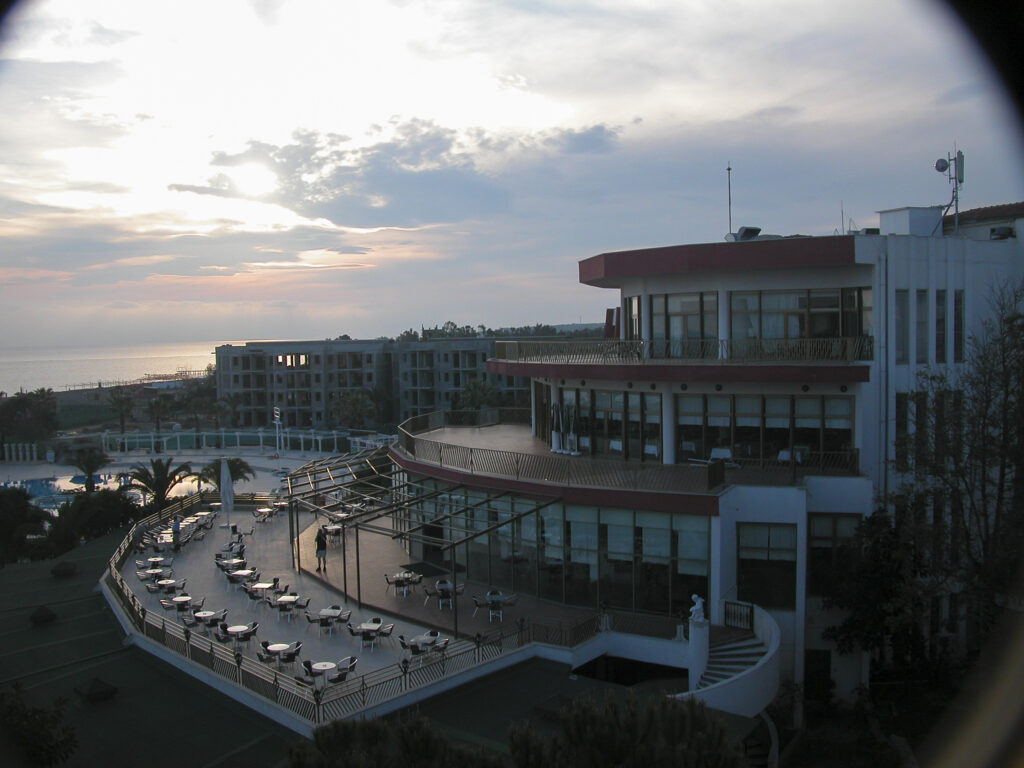We viewed the Total Solar Eclipse of 2006 from the grounds of the Kaya Side Hotel. Before launching into our experiences on that day, I have to say a few words about the hotel, and for that I have to begin with the evening before.
The Kaya Side Hotel is the most luxurious place I have ever stayed in, bar none. Of course I’m not the kind of person who gets to stay in posh hotels very often, but I’ve been in a few. What set it apart, however, was not the appointments, furnishings, or decor, which were all great, but the service. I have graphic evidence to show for this, as you’ll soon see.
When we first learned that we would be staying at the Kaya Side, I thought that it must be named after Kaya Tuncer, and that would be because he owed the hotel. Naturally, since he was underwriting the expedition, we would be staying in his hotel. I was soon disabused of this notion: the name was merely a coincidence, Kaya is a common name in Turkey, and Kaya means “rock” in Turkish. Mr. Tuncer’s wealth came from his involvement in the Aegean Free Zone in Izmir, and not from investment in hotels, nor did he own any. (Kaya is also the name of one of Sandie’s nephews, who lives in the Michigan Upper Peninsula, but that’s just another coincidence; his parents are not Turks and don’t know any Turkish.)
I also learned that the Kaya Side, like all the other hotels in Side, was normally closed at this time of year; they had only opened for the eclipse and would shut down until summer after we left.
The night before the eclipse, we returned dead tired from our day in the antique ruins of Pamphylia, to find that our room had been specially fitted out in honor of our wedding anniversary:
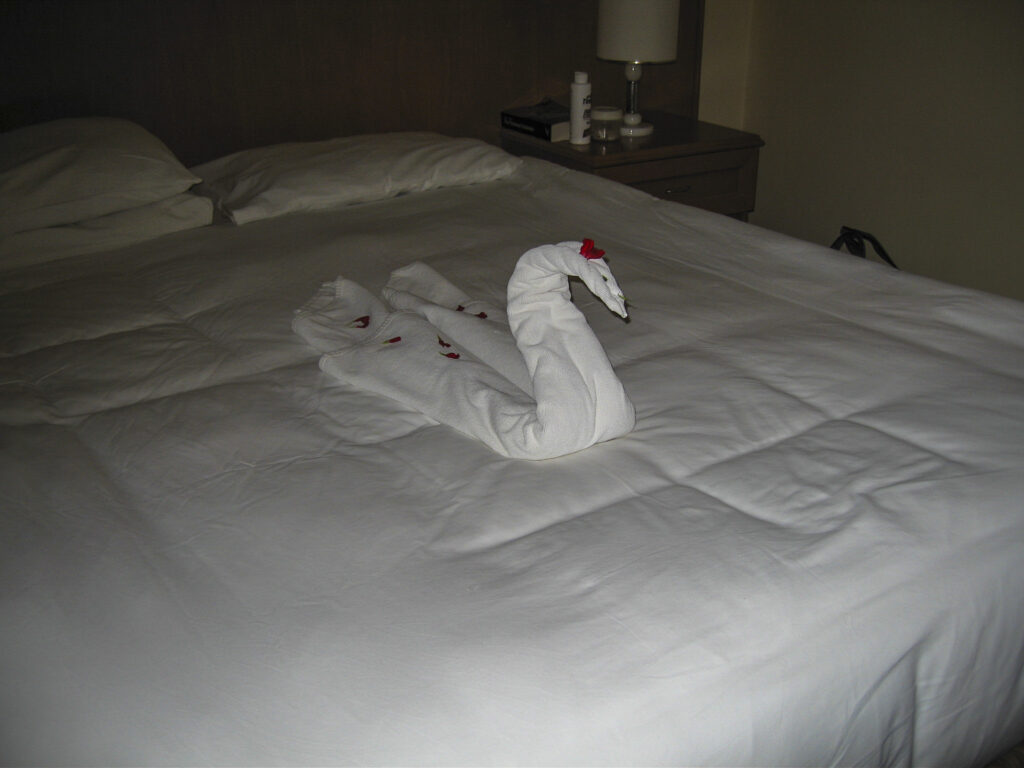
Among the amenities provided as a matter of course were bathrobes, slippers, and a nice travel bag, which I still have.
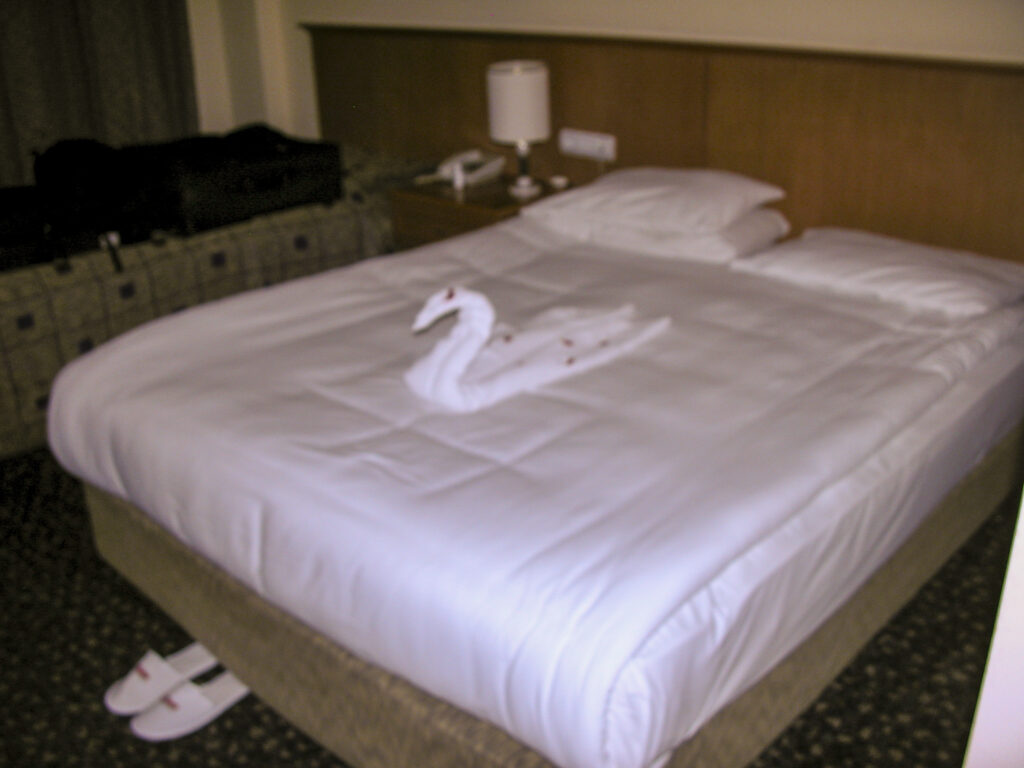
The towel folded in the shape of a swan, with rose petals sprinkled over it, was unlike anything I’ve seen before or since, and it was just one of the many features that put the Kaya Side in a class by itself.
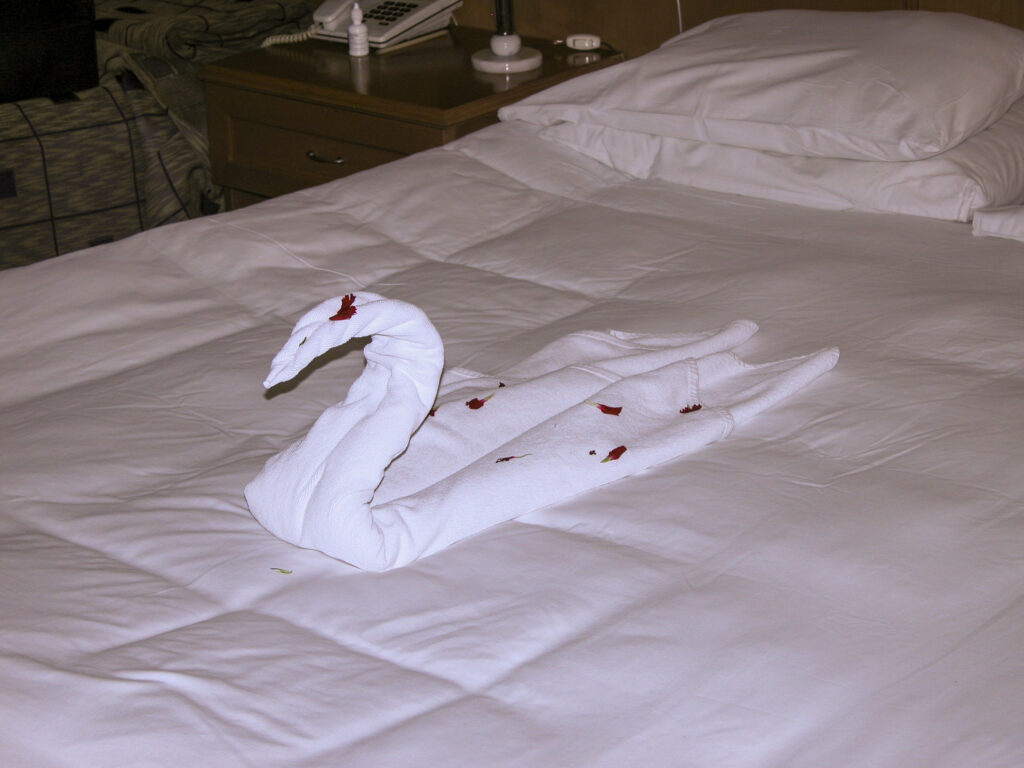
I wasn’t surprised by the amazingly soft and absorbent towels – after all, Turkish towels were invented in Bursa, Turkey, in the 17th century. That’s why they’re called Turkish towels.
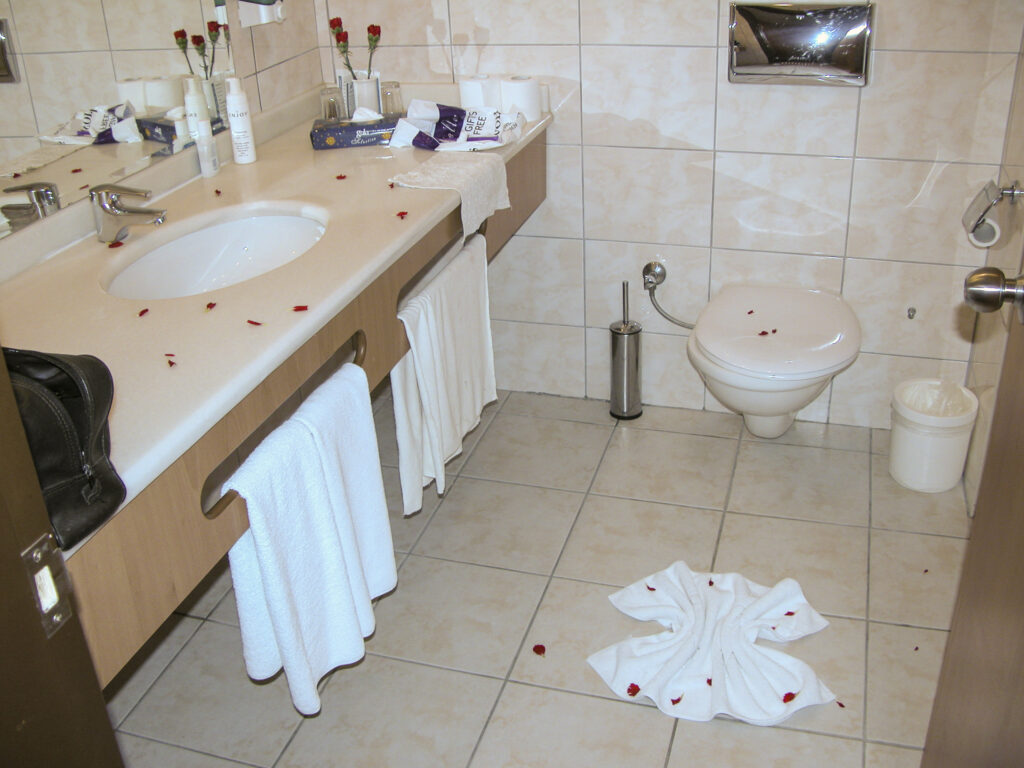
The roses in the vase in the bathroom were real, of course. And so was the complimentary bottle of champagne that awaited us – which, unfortunately, we forgot to photograph before we drank it up.
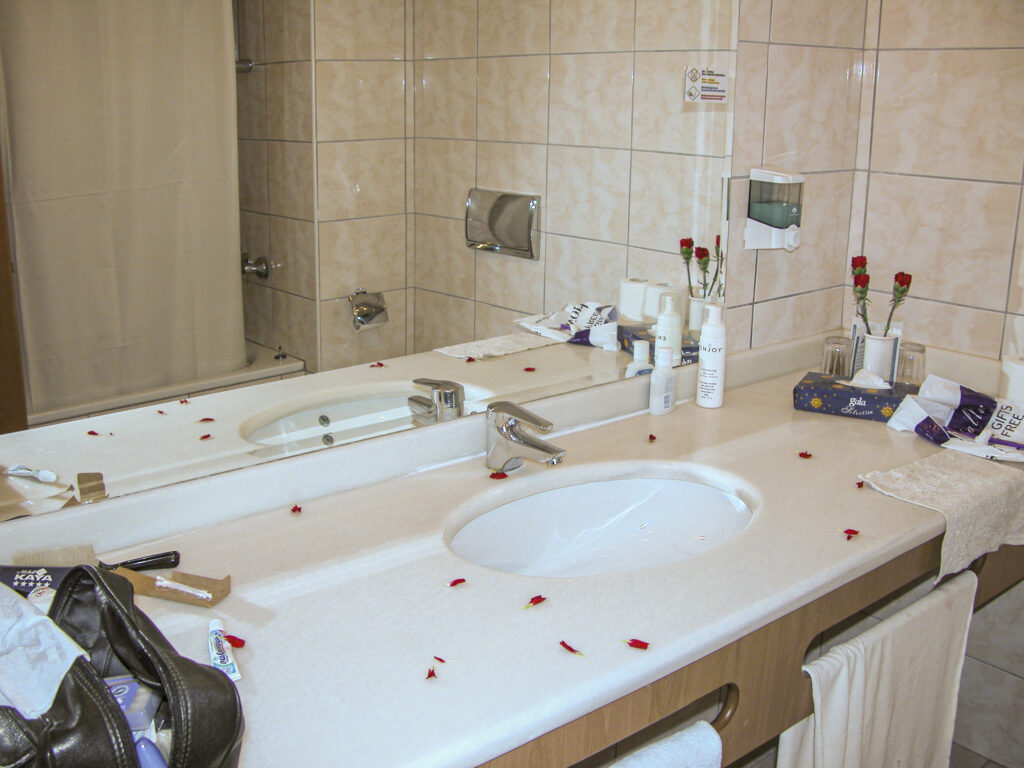
Eclipse Day, March 29, dawned bright and clear, and we started schlepping our gear out toward the beach behind the hotel to set up for the big event.
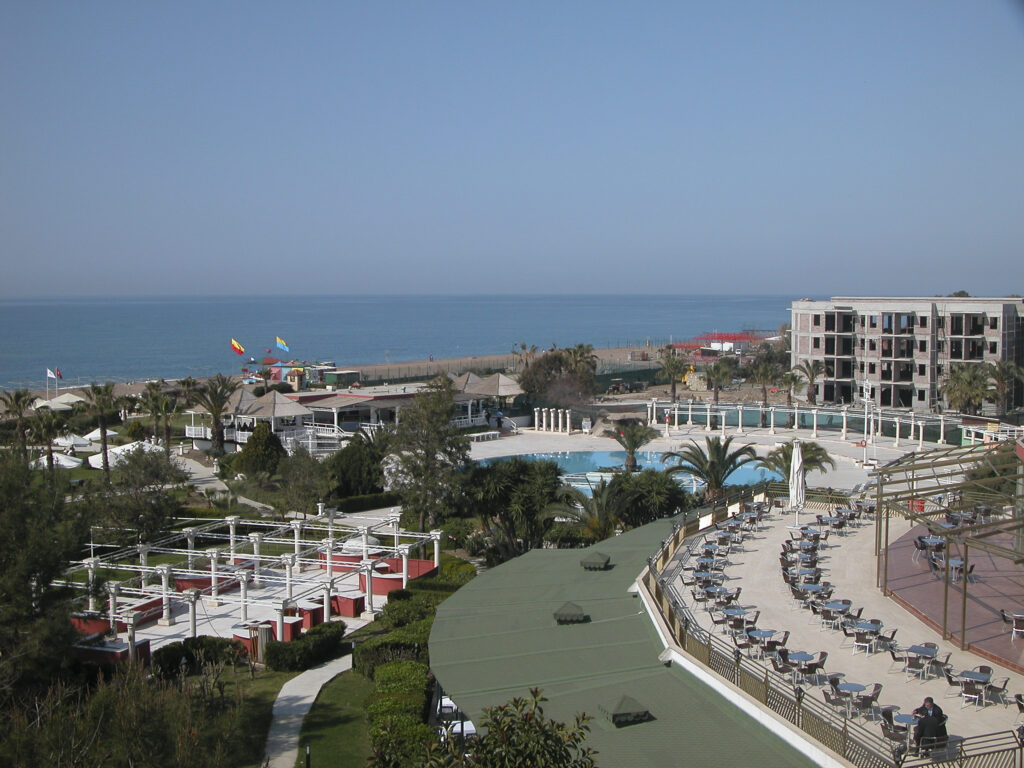
In the summer the beach would have been filled with vacationers under umbrellas (you can see the naked umbrella frames in this picture). But today there were no beachgoers, just eclipse-chasers, who, fortunately, did not have to set up their scopes on the sandy beach itself, but rather on the paved area in back of the hotel.
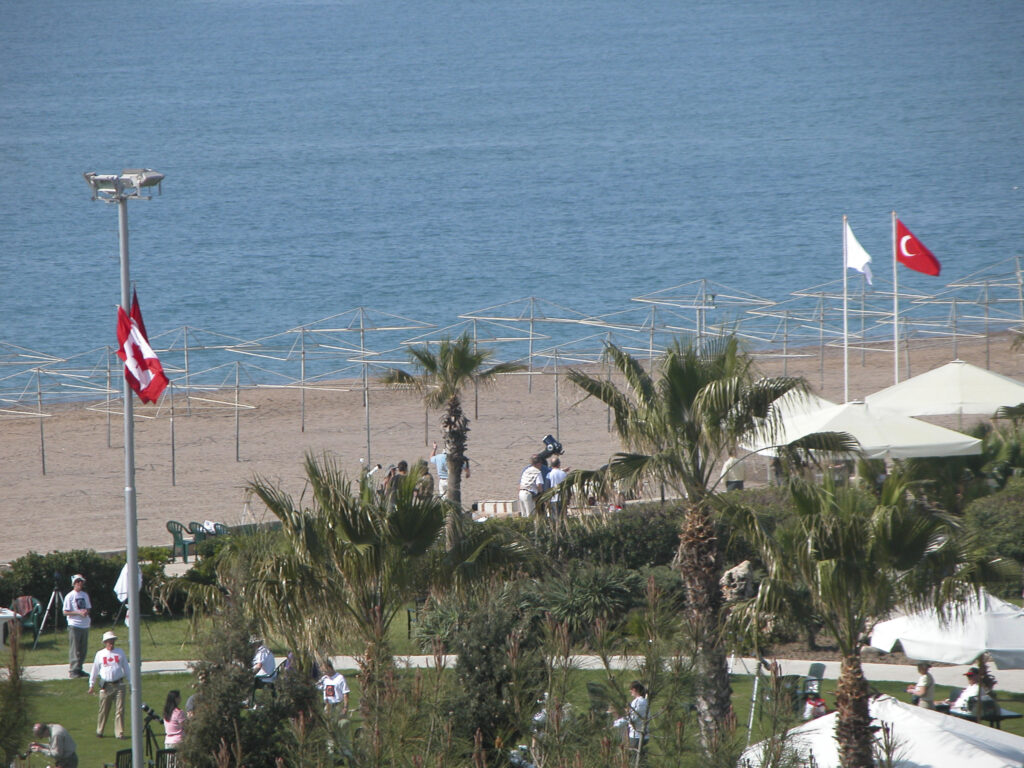
On a normal summer day there would have been dozens of paddleboats and jet skis, but this was early spring, and the water was cold, and anyway people were only here for the eclipse.
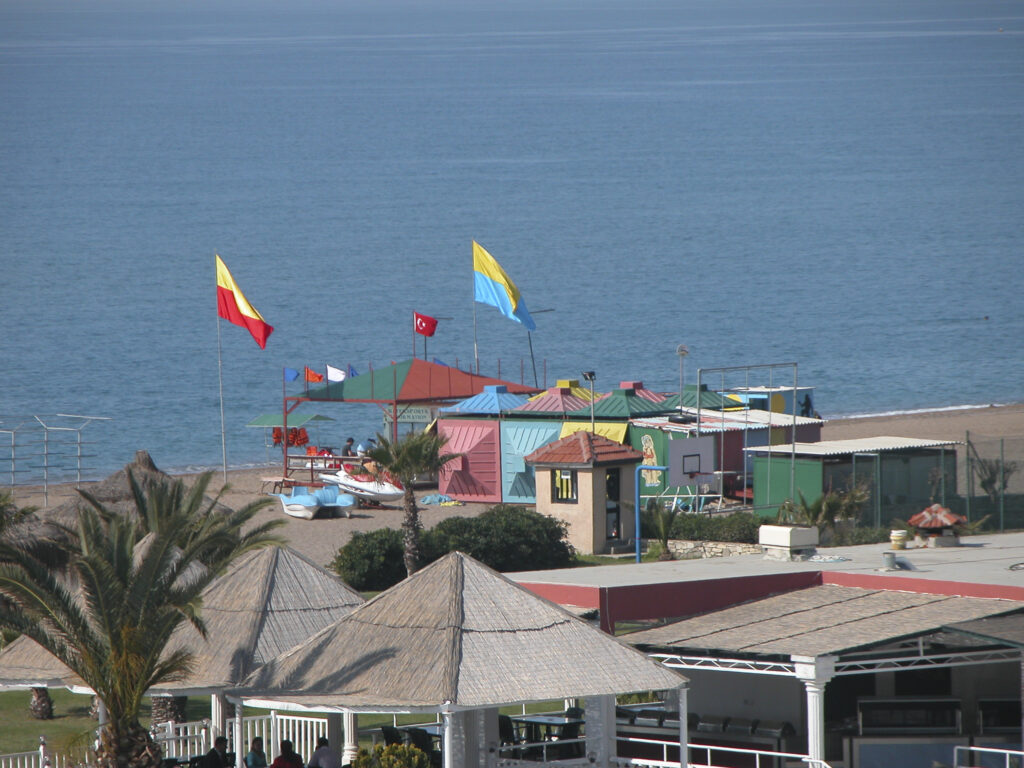
I began to set up the equipment I had brought to shoot the eclipse, while Sandie shot me. My equipment was fairly simple: a TeleVue Pronto 70mm refractor with a Baader mylar white-light solar filter on a non-motorized, unguided TelePod mount, and an Olympus OM-1 film camera. Astrophotography-wise, I had not yet updated to the digital age in 2006.
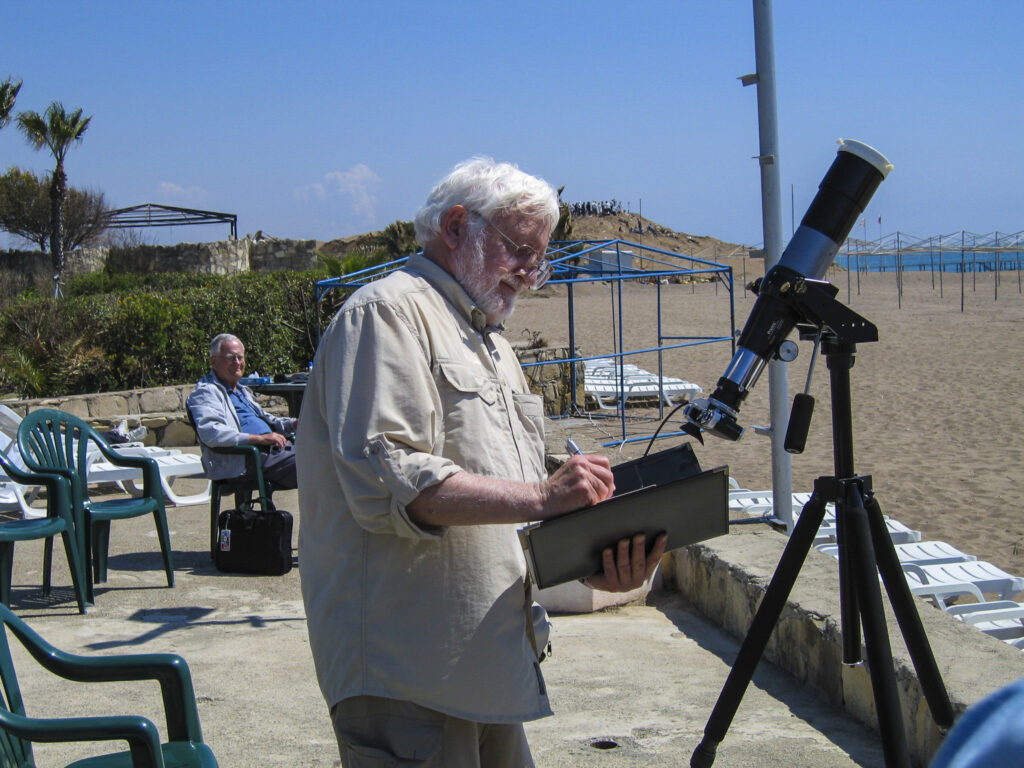
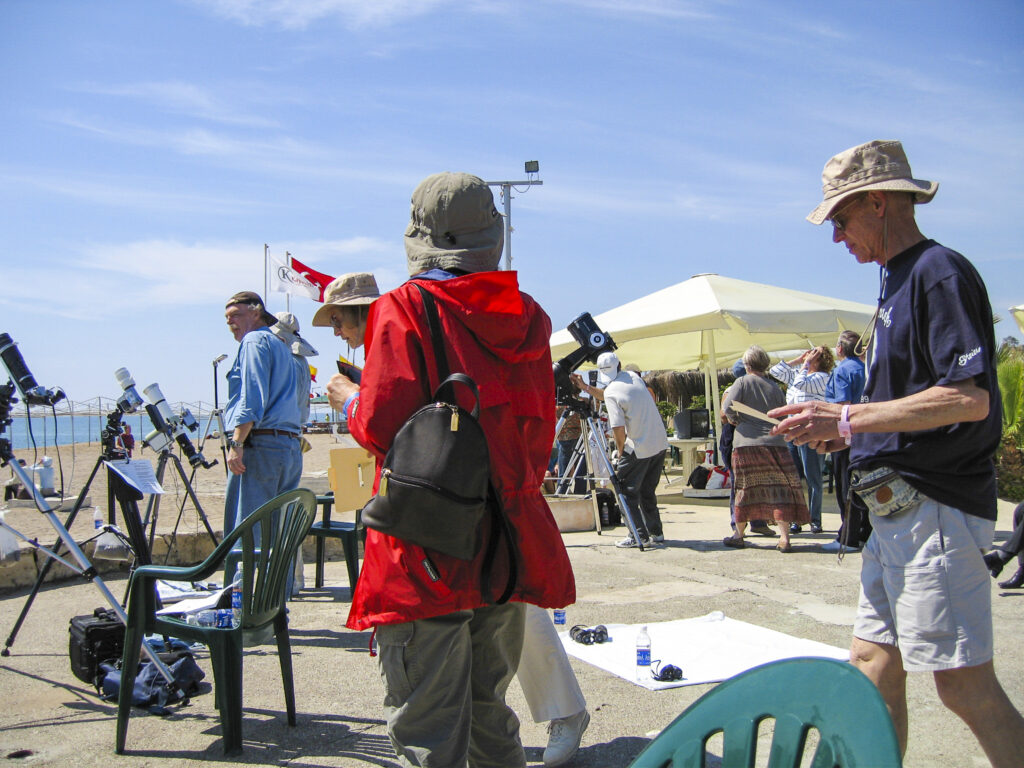
Jim Windlinger brought a superb array of equipment to the 2006 eclipse – a Borg telescope, all-automated mount and guiding apparatus, digital camera. But it was the Nazar Boncuk hanging from the counterweight shaft that was the real secret of his success.
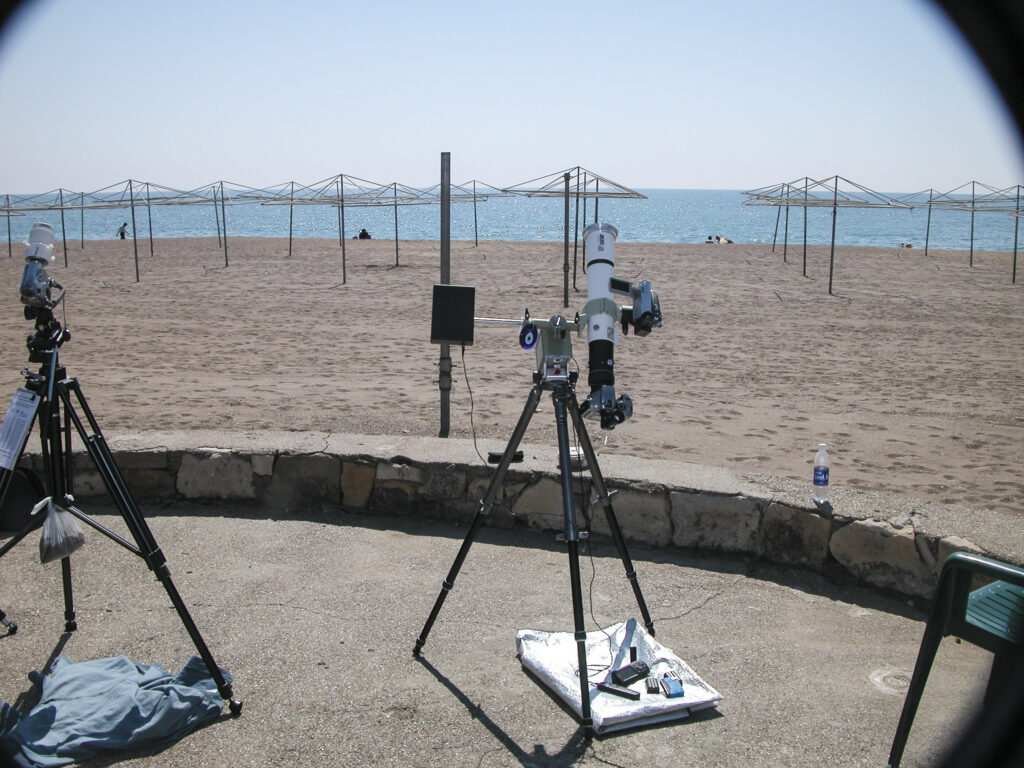
A group of people from a neighboring hotel which did not offer facilities as nice as the Kaya Side gathered on a hill to watch the eclipse. I guess they thought they would get a better view if they climbed closer to the Sun.
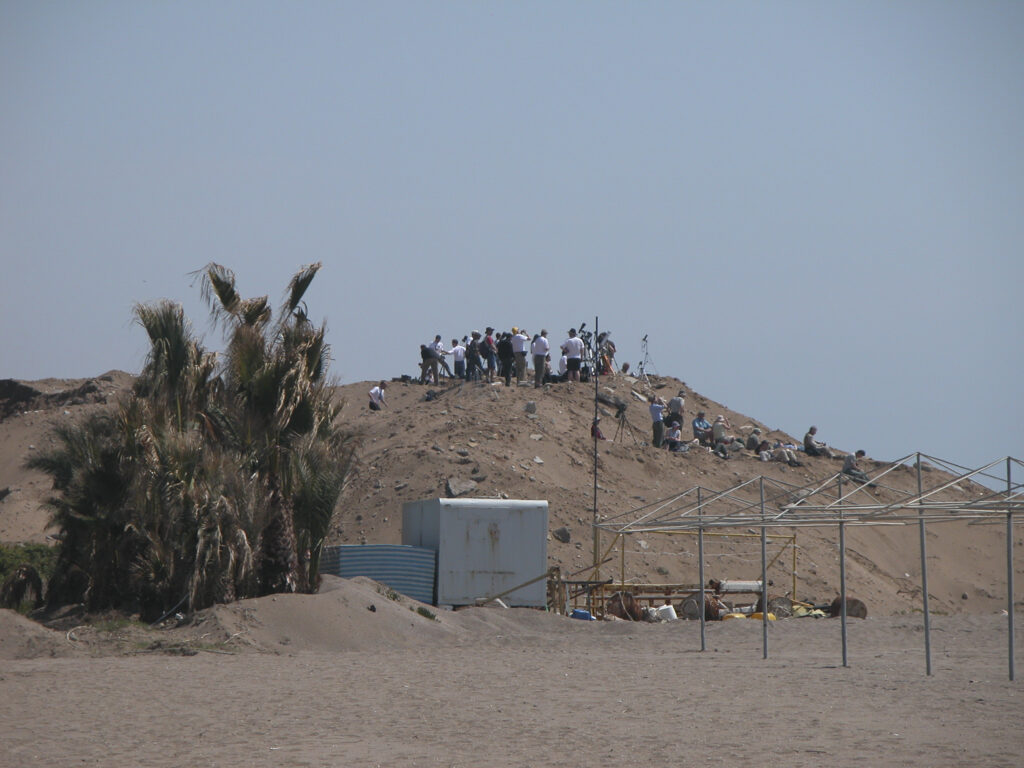
Michelle Evans brought the largest scope in our tour group, an 8″ Meade LX-200 Schmidt-Cassegrain, which she had borrowed from Space Camp Turkey. It was equipped for viewing only since no camera adapters for it were available. Some photographers were content with cameras on tripods (right of center). Others didn’t even have tripods, and did the best they could with hand-held cameras.
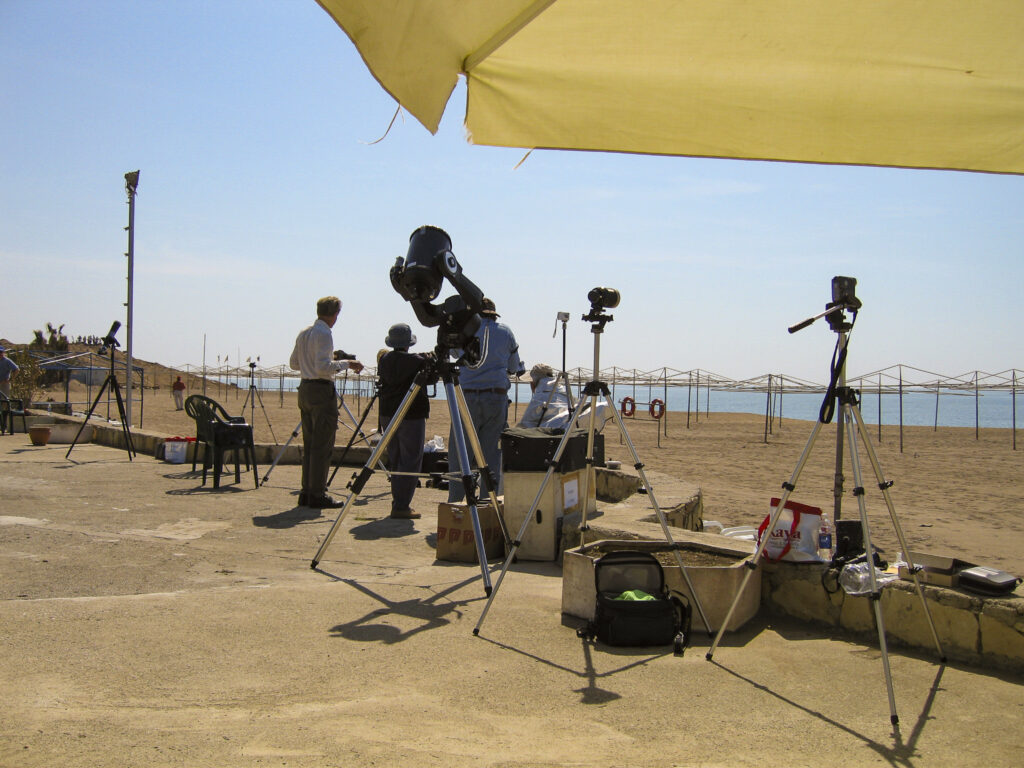
Michelle Evans had a hand-held camera to shoot the eclipse; in the photo below it appears that she has attached a periscope to it. But this is an optical illusion; if you look closely, you can see that the “periscope” is actually a pole stuck in the concrete behind her. Meanwhile, Chuck Mattox, just to the left of Michelle, appears to be stomping on an insect about to spring on the girl in front.
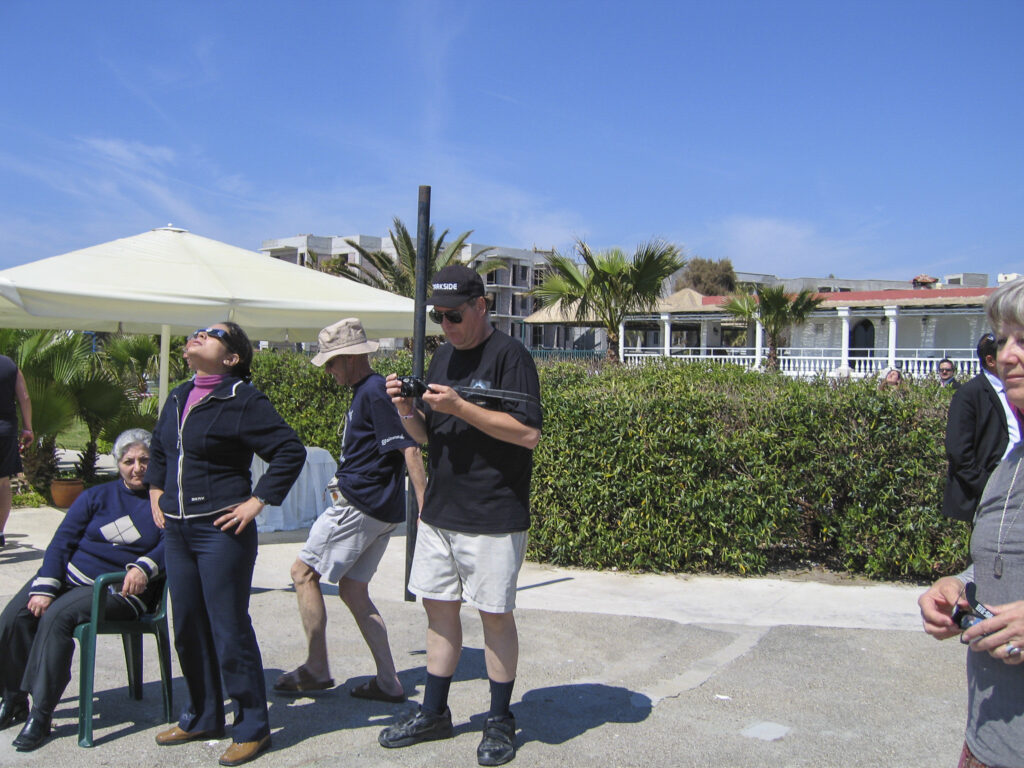
First contact! The Moon begins to nibble at the edge of the sun.
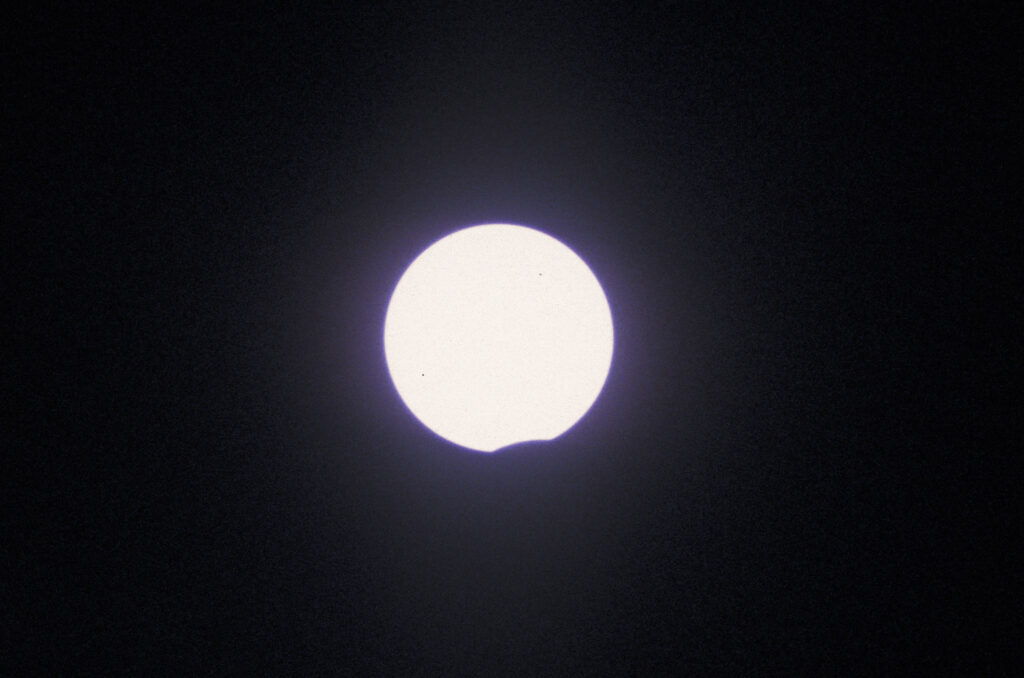
Someone brought a bed sheet, which they spread out on the ground with the intent of using optical devices to project onto it sharp and well-defined images of the Sun being eclipsed by the Moon.
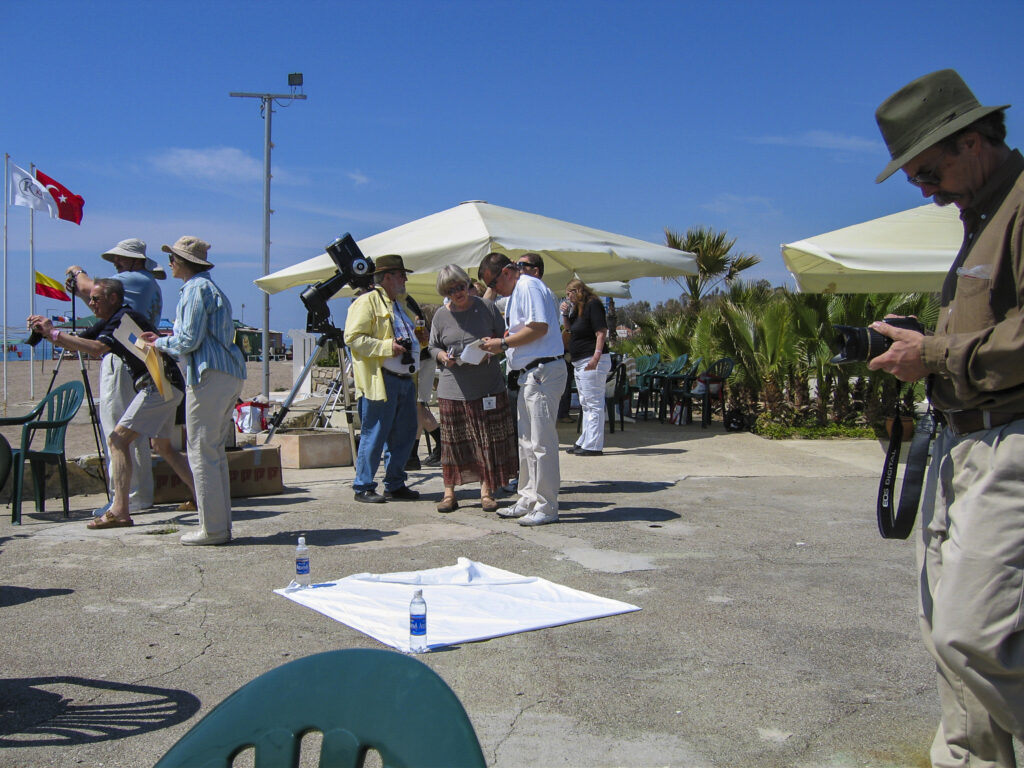
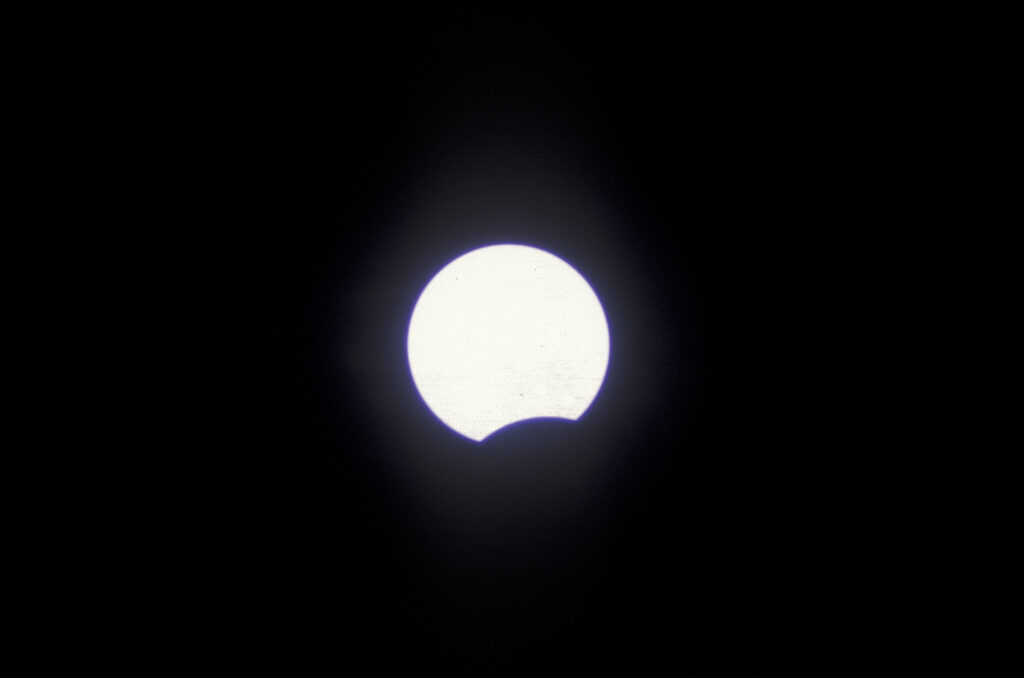
Sandie used a pair of small binoculars to project the image of the Sun being eclipsed by the Moon onto the bedsheet, and I photographed it.
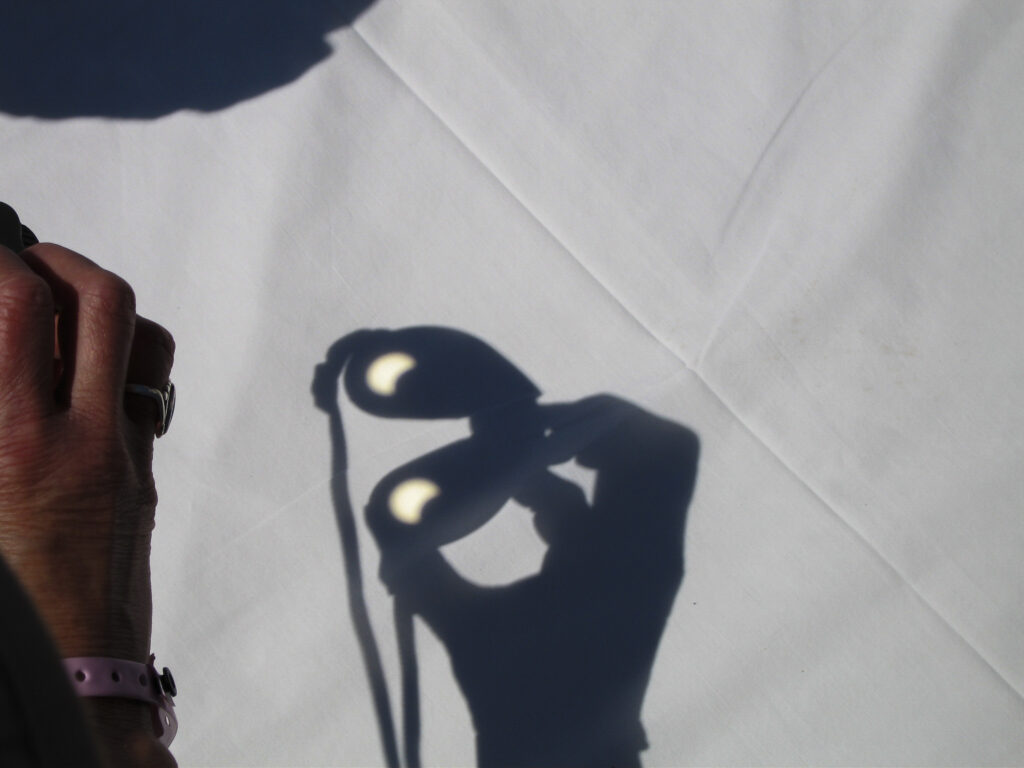
I alternated between watching the eclipse, hobnobbing with other watchers, and adjusting my equipment. Since my mount was not motorized or guided, and thus could not track the Sun on its own, I had to continually adjust it to keep the Sun in view.
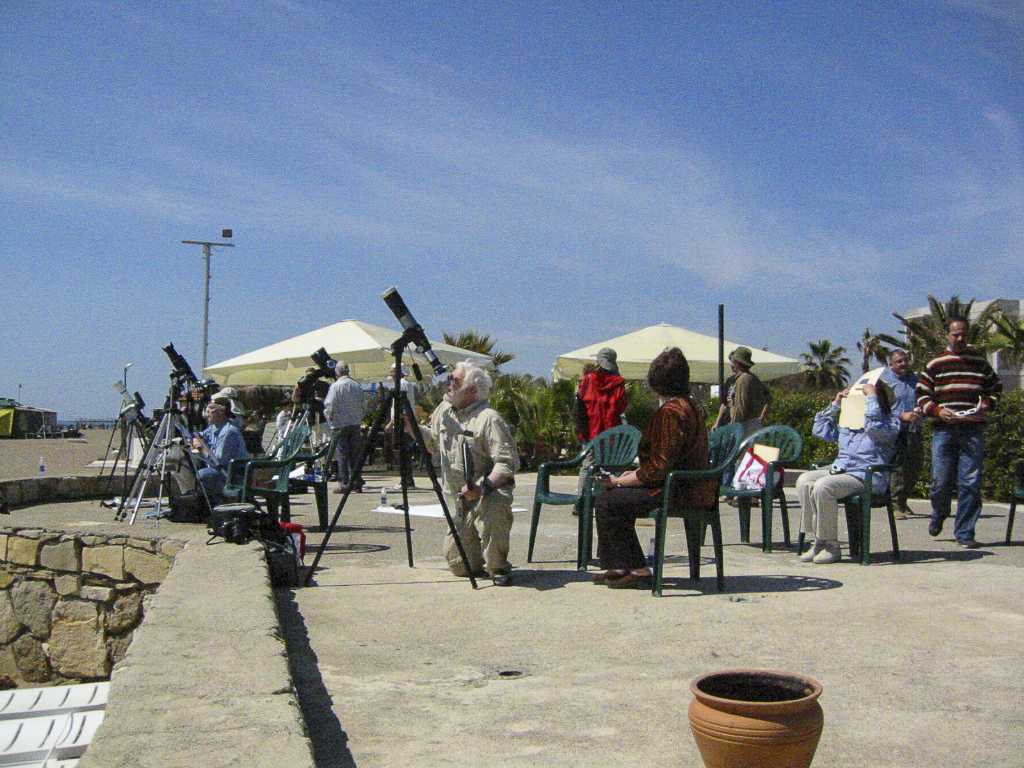
Keeping the Sun’s image centered was a bit of a challenge. The sun was high in the sky, so the scope had to be pointed upward at a steep angle; consequently the camera was low down, and I had to get on my knees and contort myself to see through the viewfinder. The mount could be adjusted only in altitude and azimuth, i.e. straight up/down and right/left horizontally, and making those adjustments while bent like a pretzel was tricky. But I managed to do that and even shoot some pictures now and then.
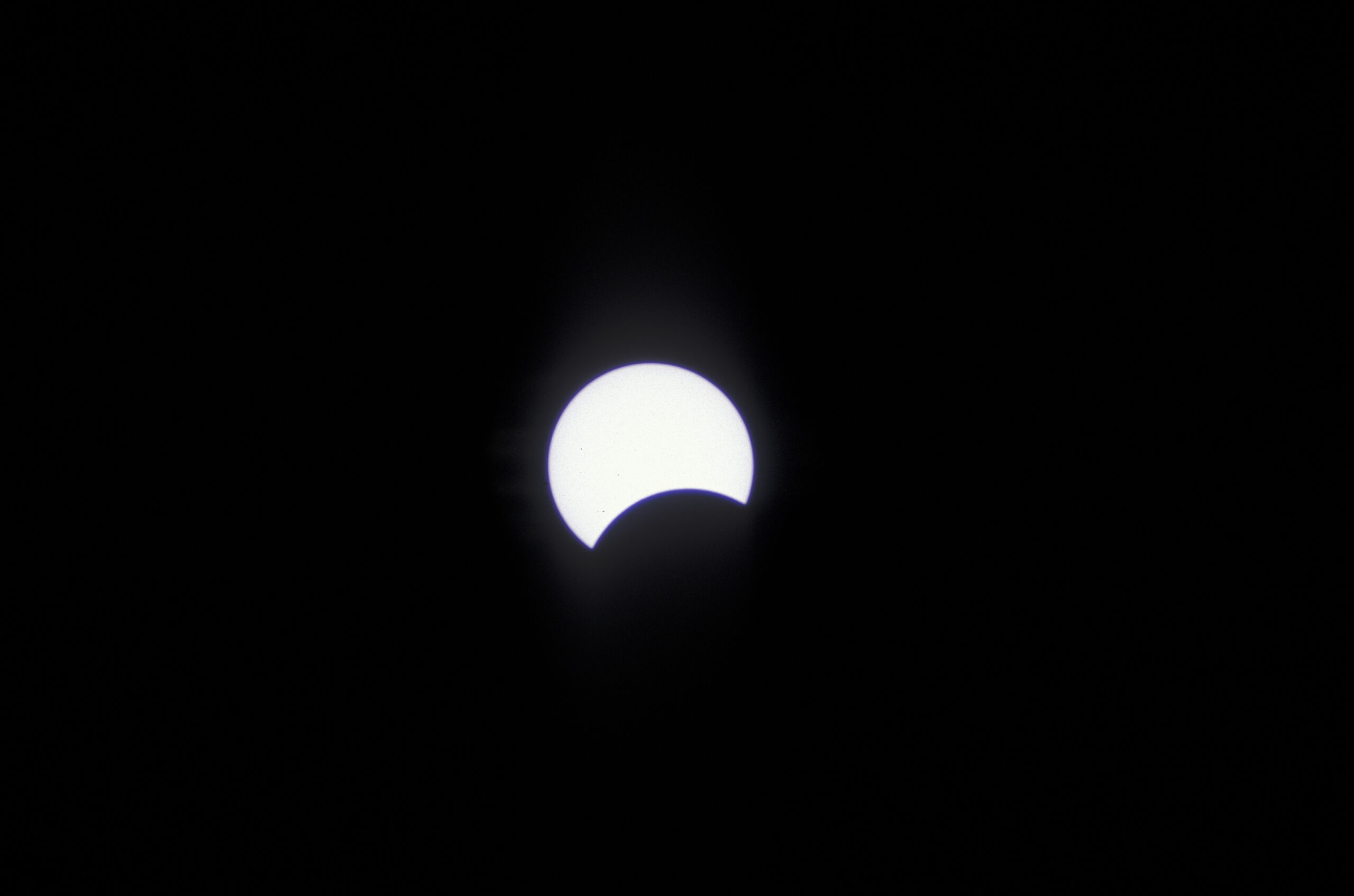
Rick Gering and Jim Windlinger with their guided mounts could be a little more relaxed, but they still had to keep tabs on the tracking; none of these devices are perfect.
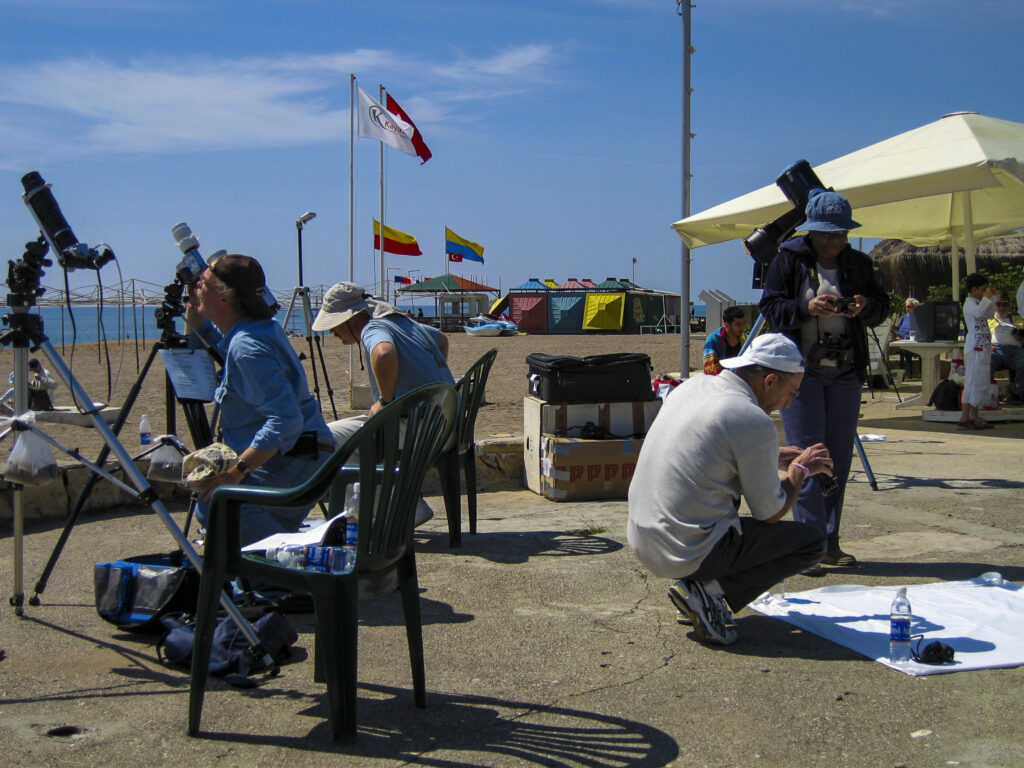
While I was fussing with my gear and shooting pictures through my scope, Sandie and others continued to shoot the eclipse image cast onto the bedsheet with binoculars with their hand-held digital cameras.
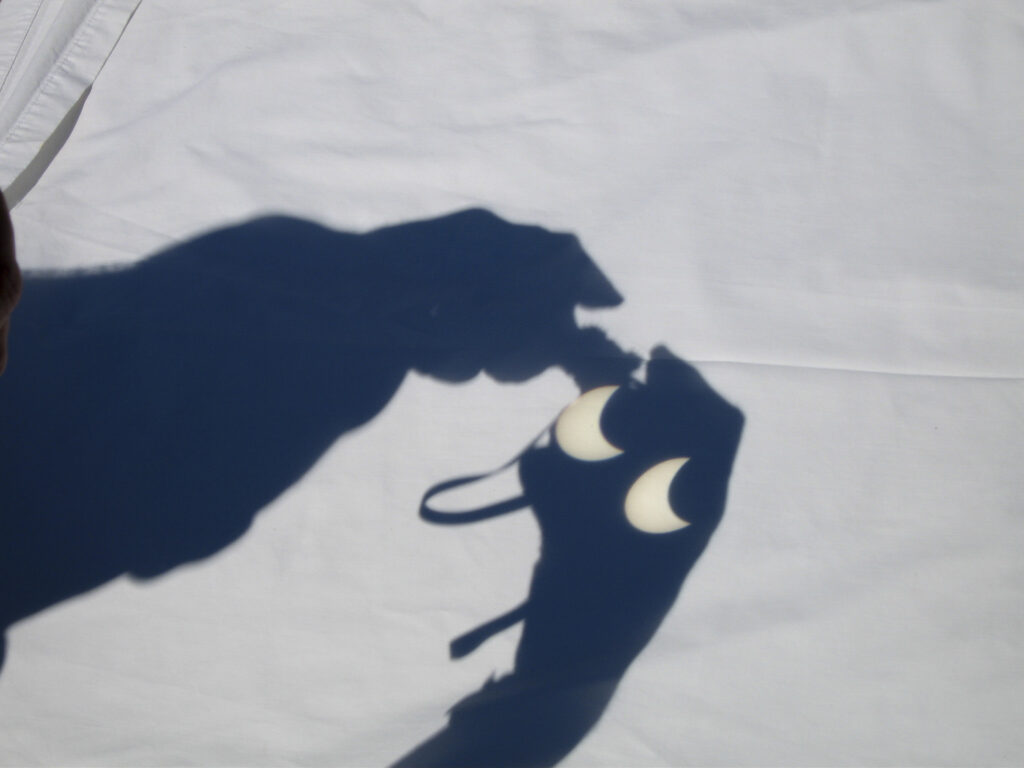
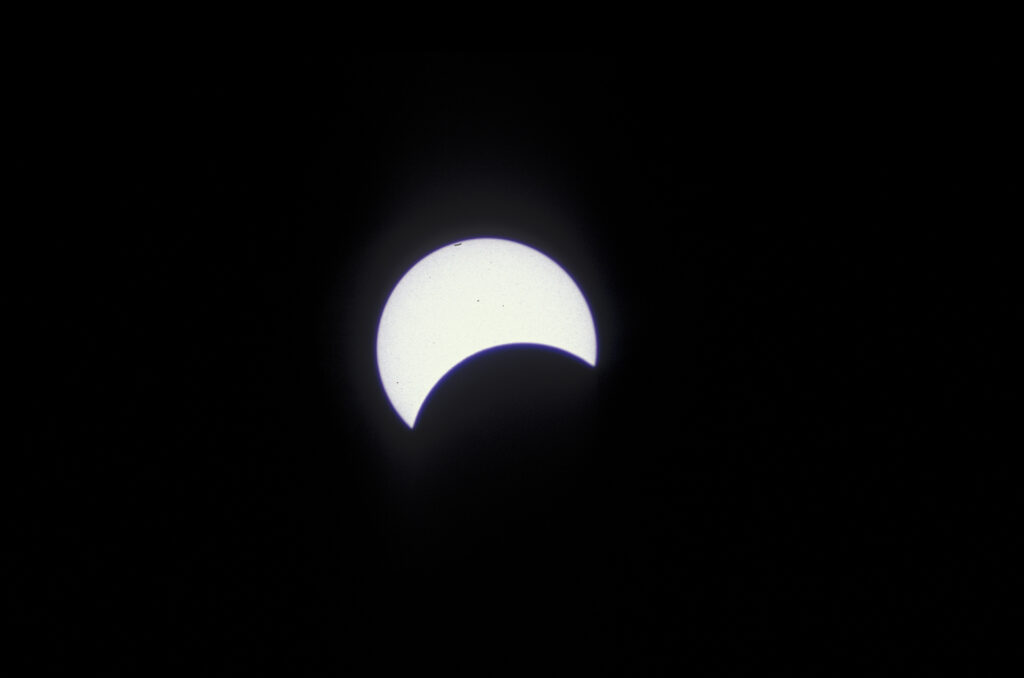
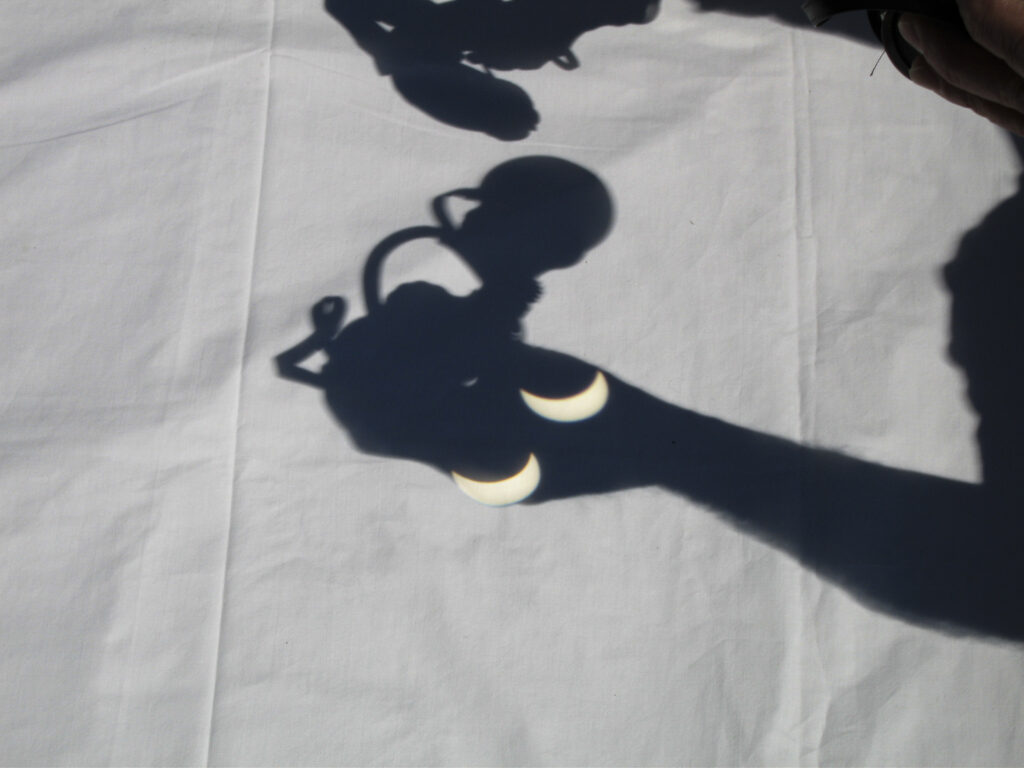
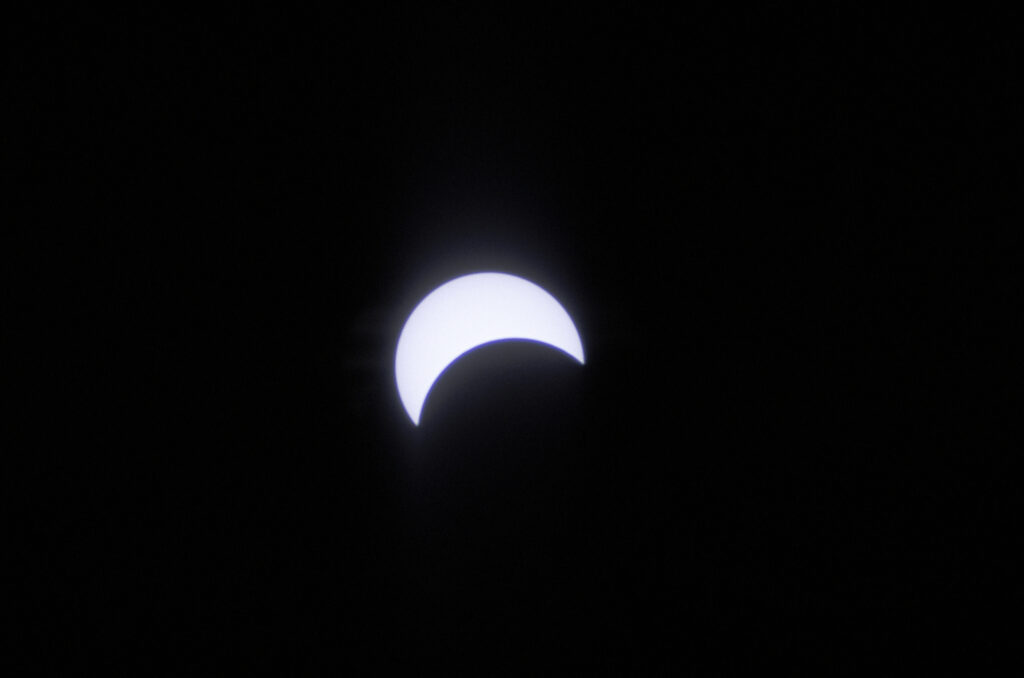
Experienced eclipse-watchers know that when the Sun’s light is filtered through foliage during the partial phases of an eclipse, it projects little crescents on the ground. Someone put a white cloth or handkerchief on the ground under a bush, and Sandie caught a shot of the little crescents with her Canon.
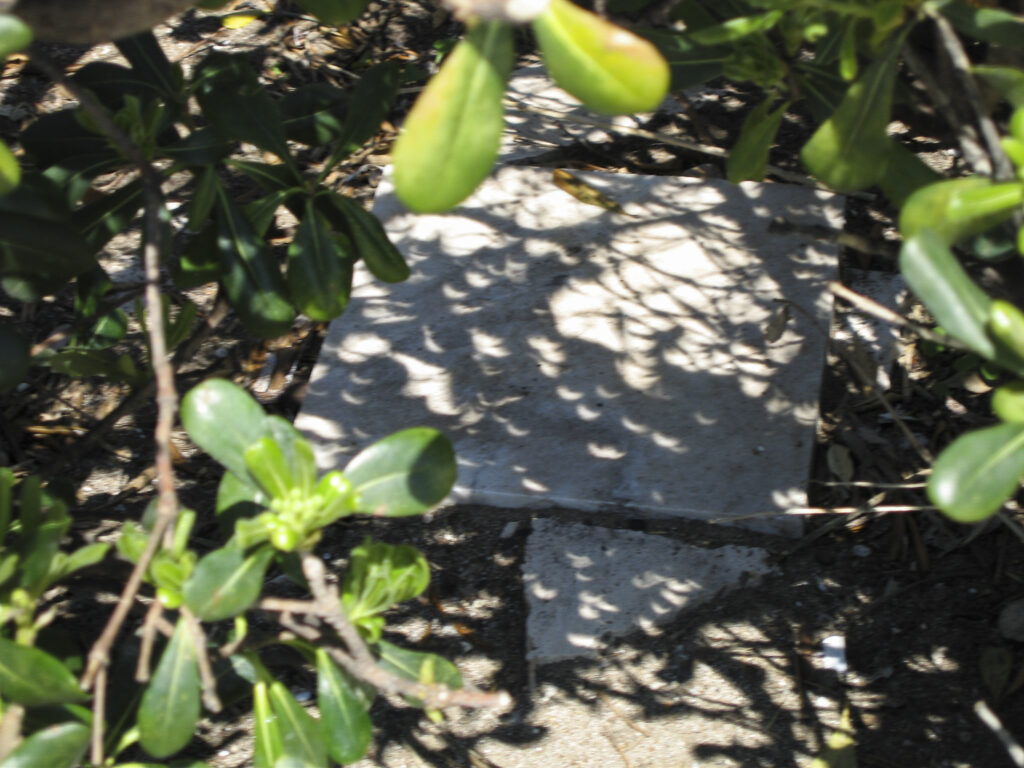
And the invisible Moon moves on.
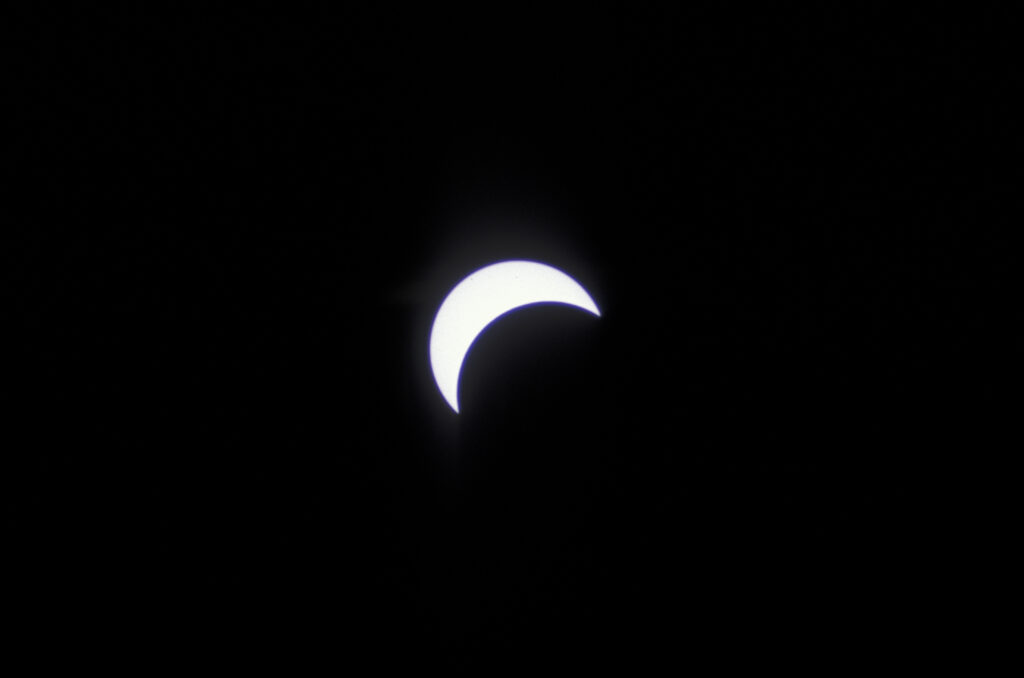
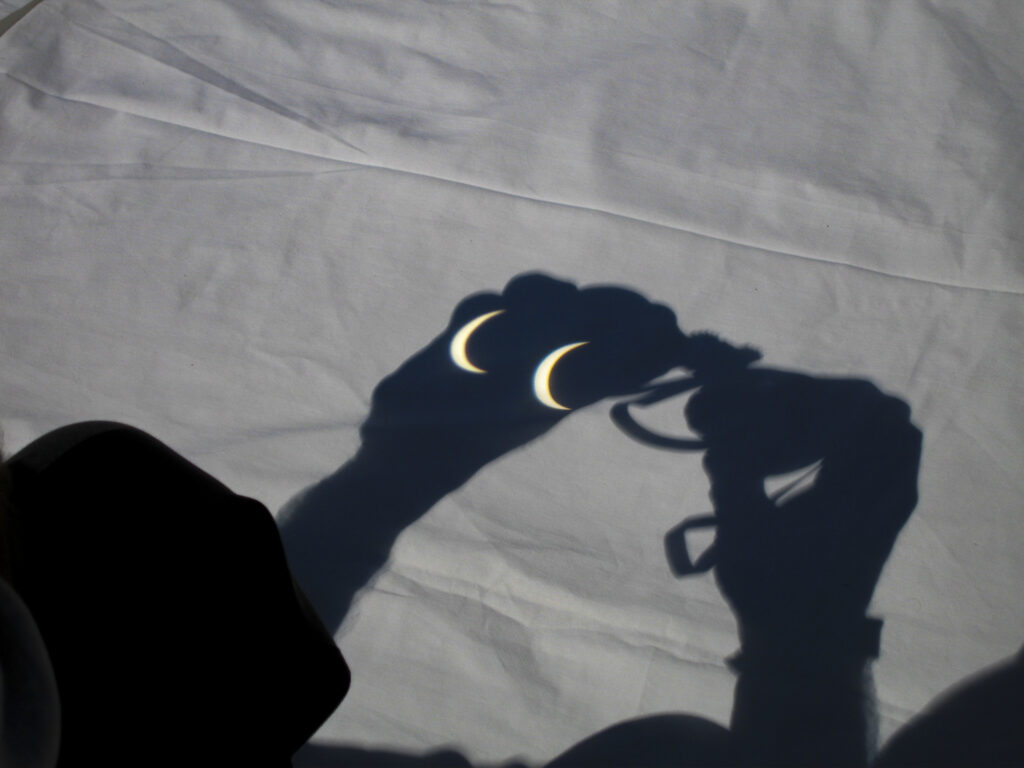
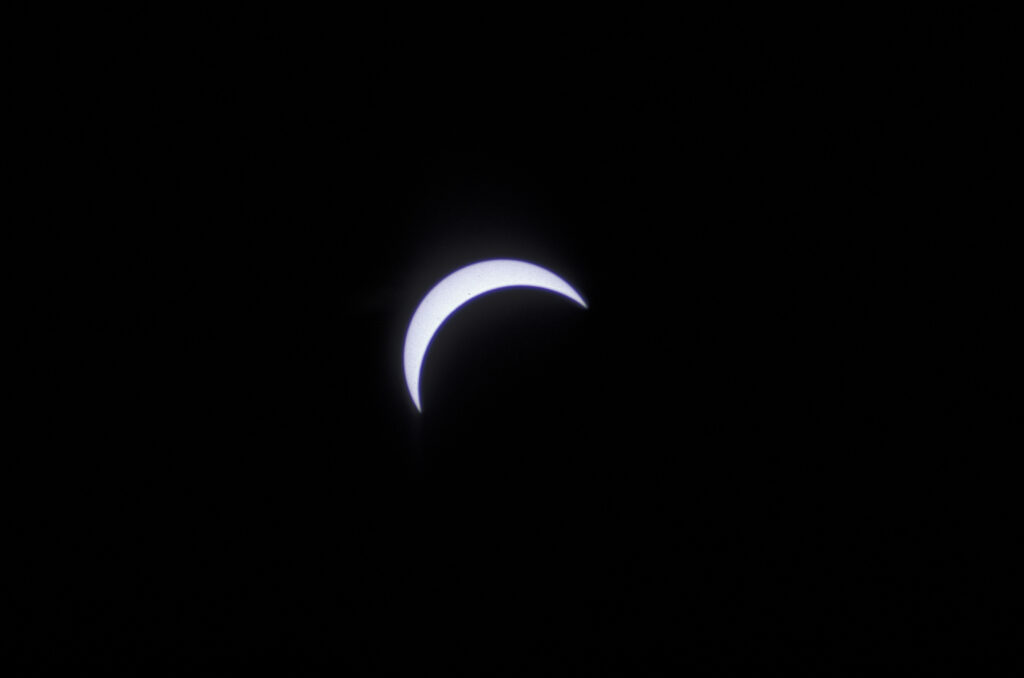
As totality drew nearer, Chuck and Elouise Mattox concocted some cockamamie apparatus to capture its onset, while I looked on with bemused scepticism. I don’t remember whether their contraption worked or not, but I applauded them for trying.
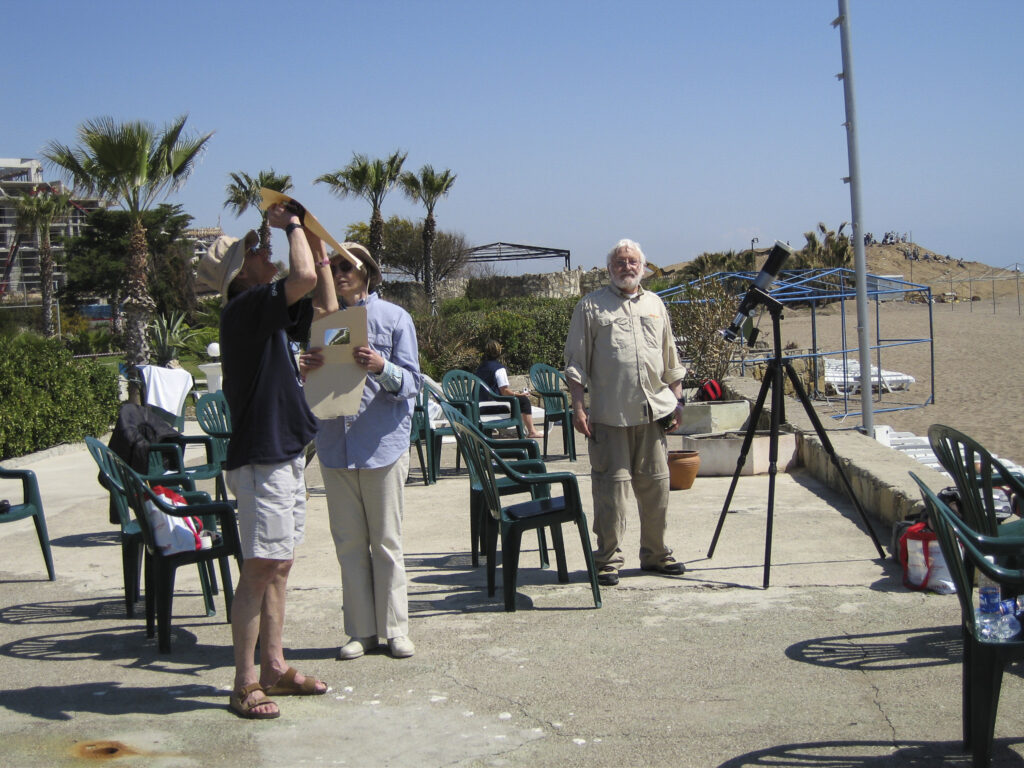
And back I went to my scope to get a few more shots on the way to totality.
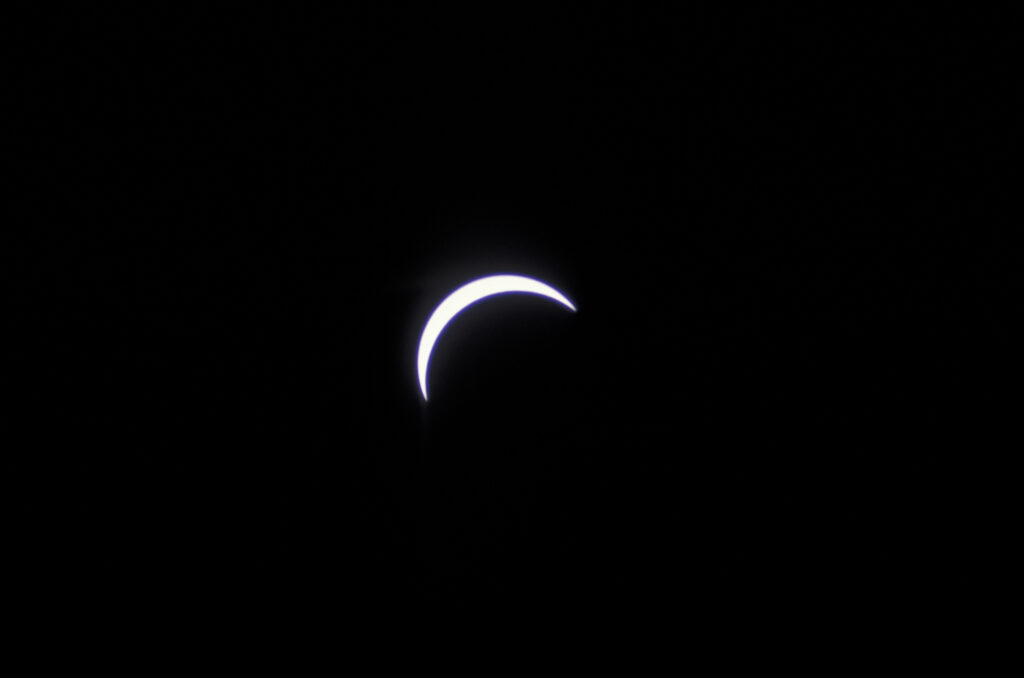
And Sandie got another shot of the little crescents in the bushes before all went dark.
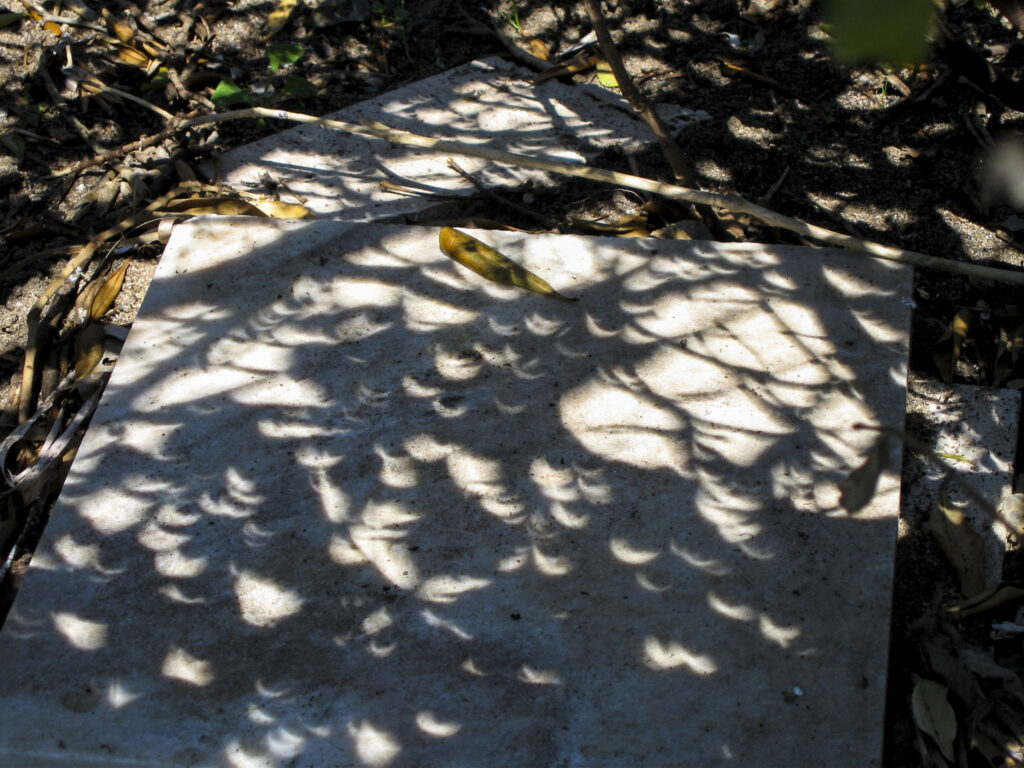
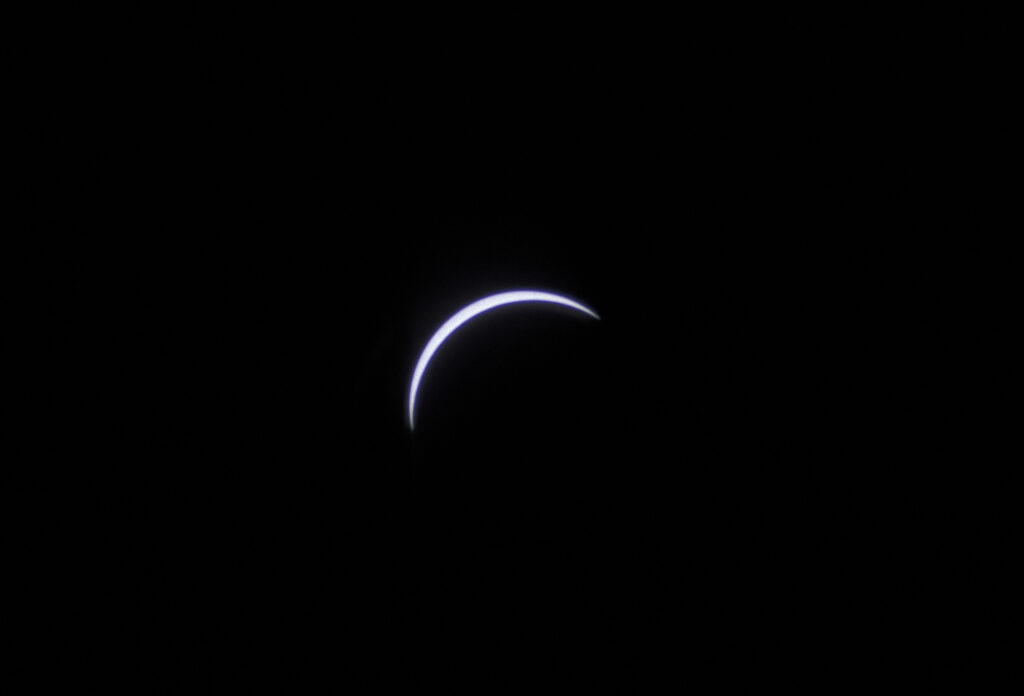
Just before totality, Sandie turned back toward the hotel and shot this slightly blurry picture of it. The light at this moment was so dim that she had to shoot with the camera lens wide open and use a shutter speed too slow to deal with camera shake.
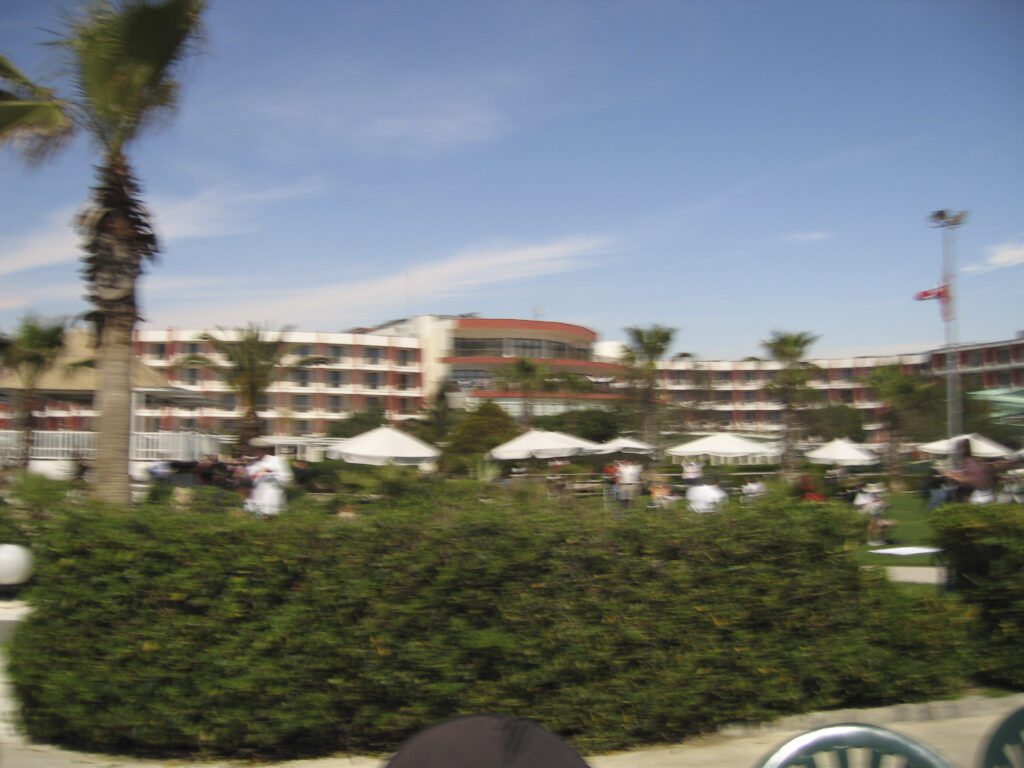
Until the Sun is about 80% covered in a solar eclipse, it’s hard to visually discern that anything is going on. But by this time, with only the thinnest crescent left unobscured, the darkening was obvious to all.
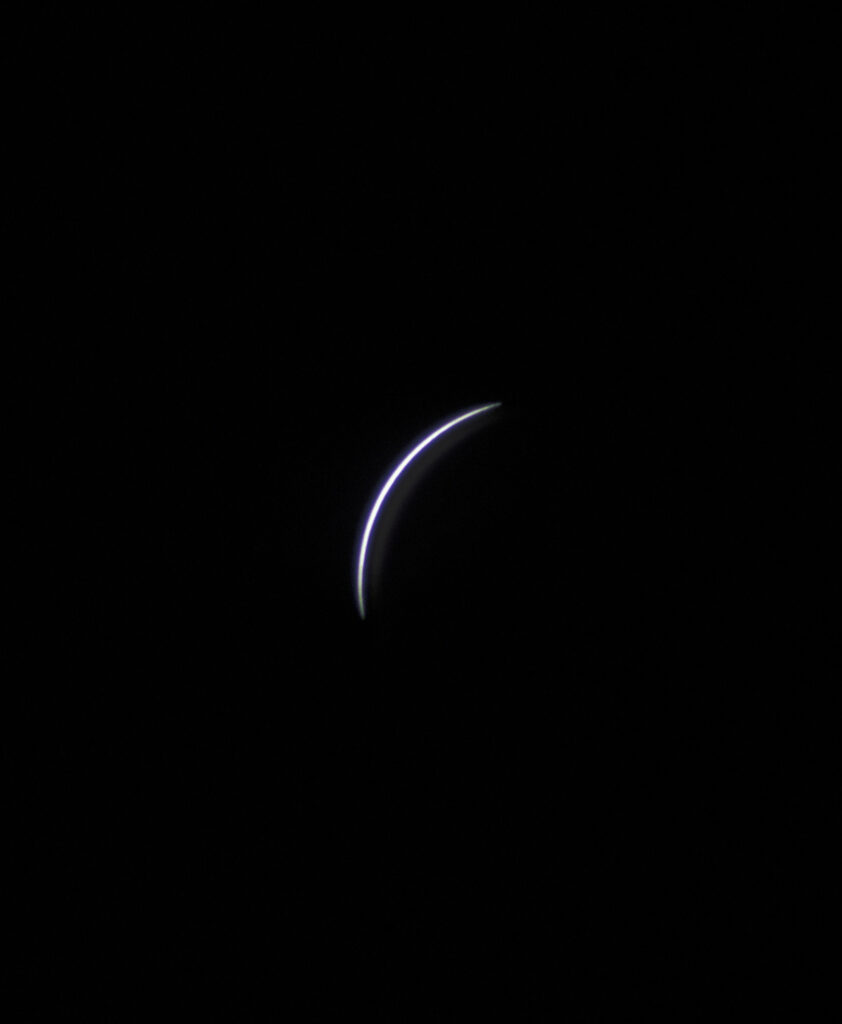
The most difficult time for a solar eclipse photographer is at third contact, the onset of totality. The trick is to judge precisely when to remove the filter, which prevents the scope and camera from being destroyed by the Sun’s brilliance, and adjust the camera to shoot without the filter. With the arrival of totality, the cutoff of direct sunlight makes it too dark to shoot at the same ISO setting used with the filter. It is every eclipse photographer’s goal to capture the so-called “diamond ring”, the bright flash at the edge that occurs right at third contact, but this requires exact timing and quick wits. Too soon and you risk blinding yourself and wreck your equipment. But if you’re too slow, you miss the diamond ring. It was particularly difficult with my film camera because I also had to advance the film after each shot. Also I wasn’t sure what ISO I had to reset to, and there was some trial and error involved. Consequently, I was too slow and miss the diamond ring at third contact.
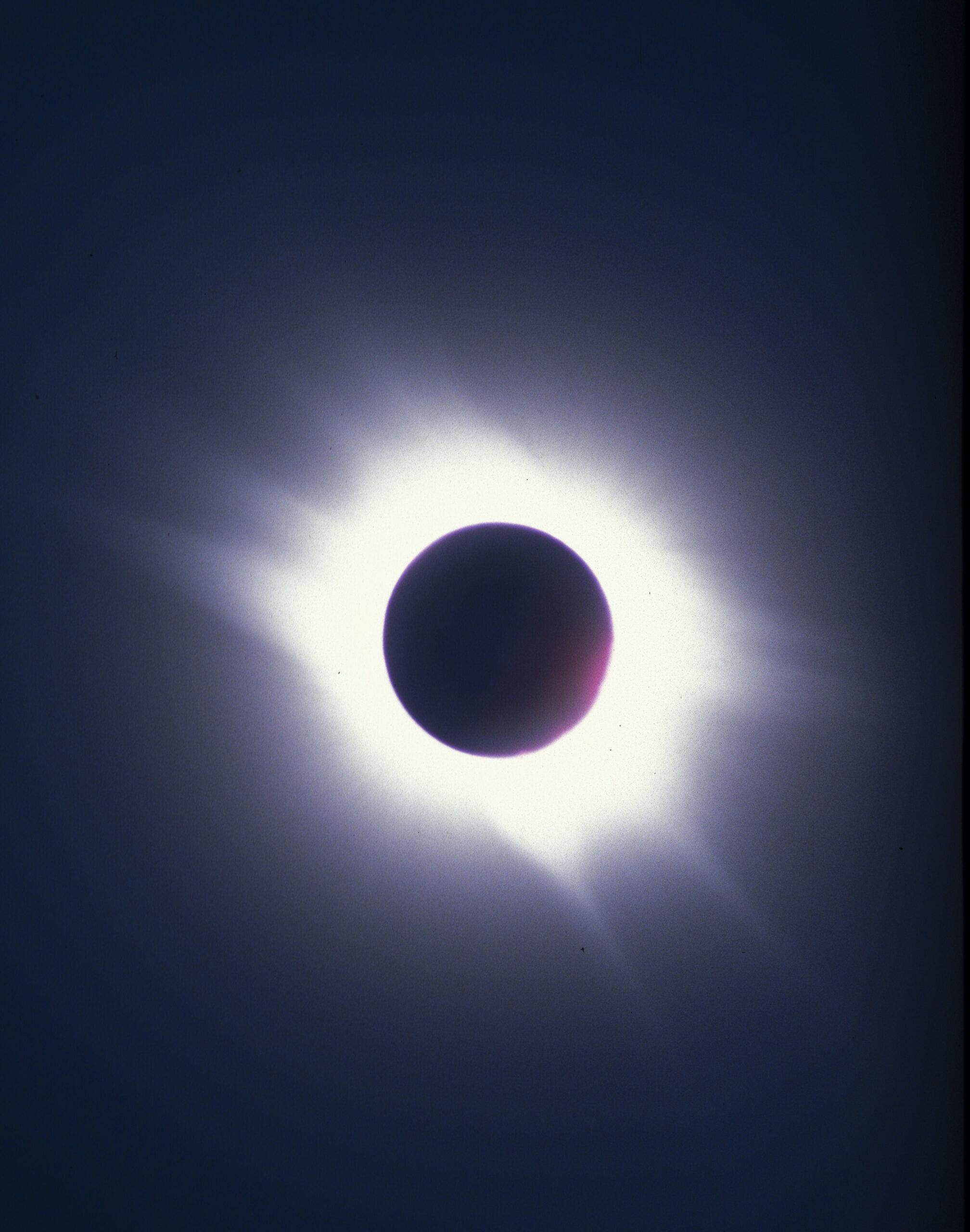
I tried several different combinations of shutter speed and and ISO during totality. None of the results were ideal, but at least I did get some not totally abhorrent shots.
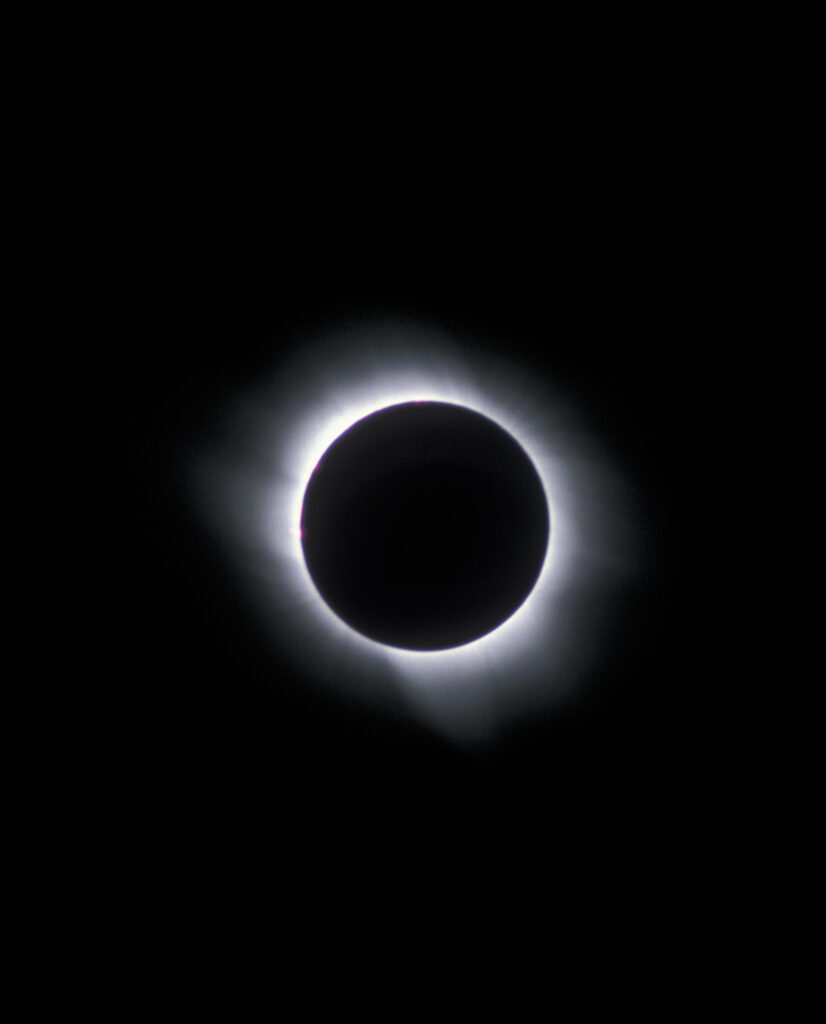
Since I was shooting with a film camera, I don’t have a metadata record of the ISO settings and shutter speeds I used. I did take notes, but I’ve lost track of them.

I also managed to get a ground shot with my Nikon digital camera during totality. I’ve left it as originally shot, without any manipulation on it with photo editors such as Photoshop or Lightroom, so it reproduces fairly faithfully the deep twilight we experienced during totality.
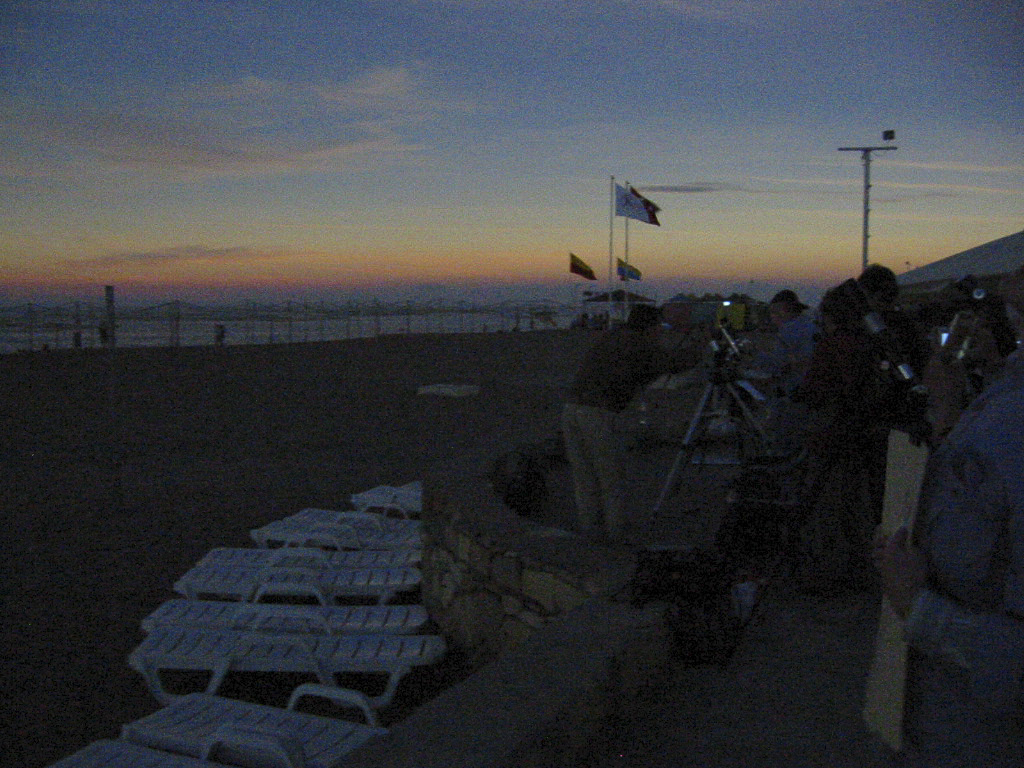
Sandie also shot a picture of the beach at totality.
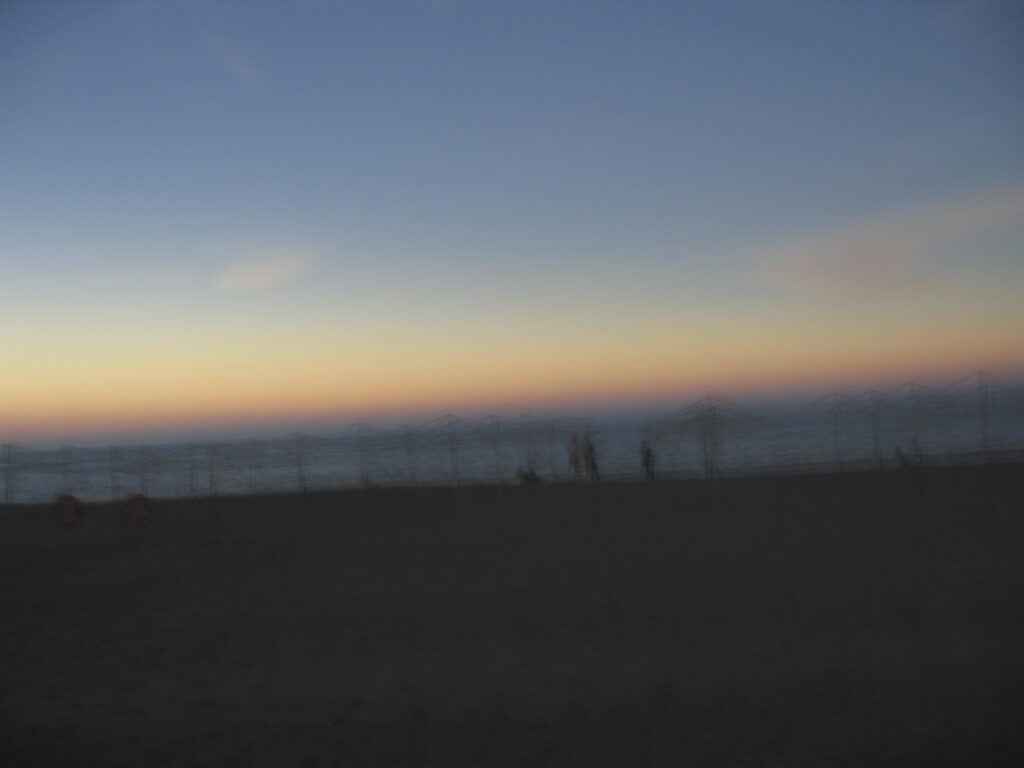
During totality I had time to hone in the camera settings, and I wasn’t in a rush to put the solar filter back on, so I was able to catch the diamond ring at third contact, as the Moon began to move off the Sun. Timing is still a bit tricky with a manual setup, and it’s not the best-ever diamond ring photo, but it was a big thrill for me to get one at all.
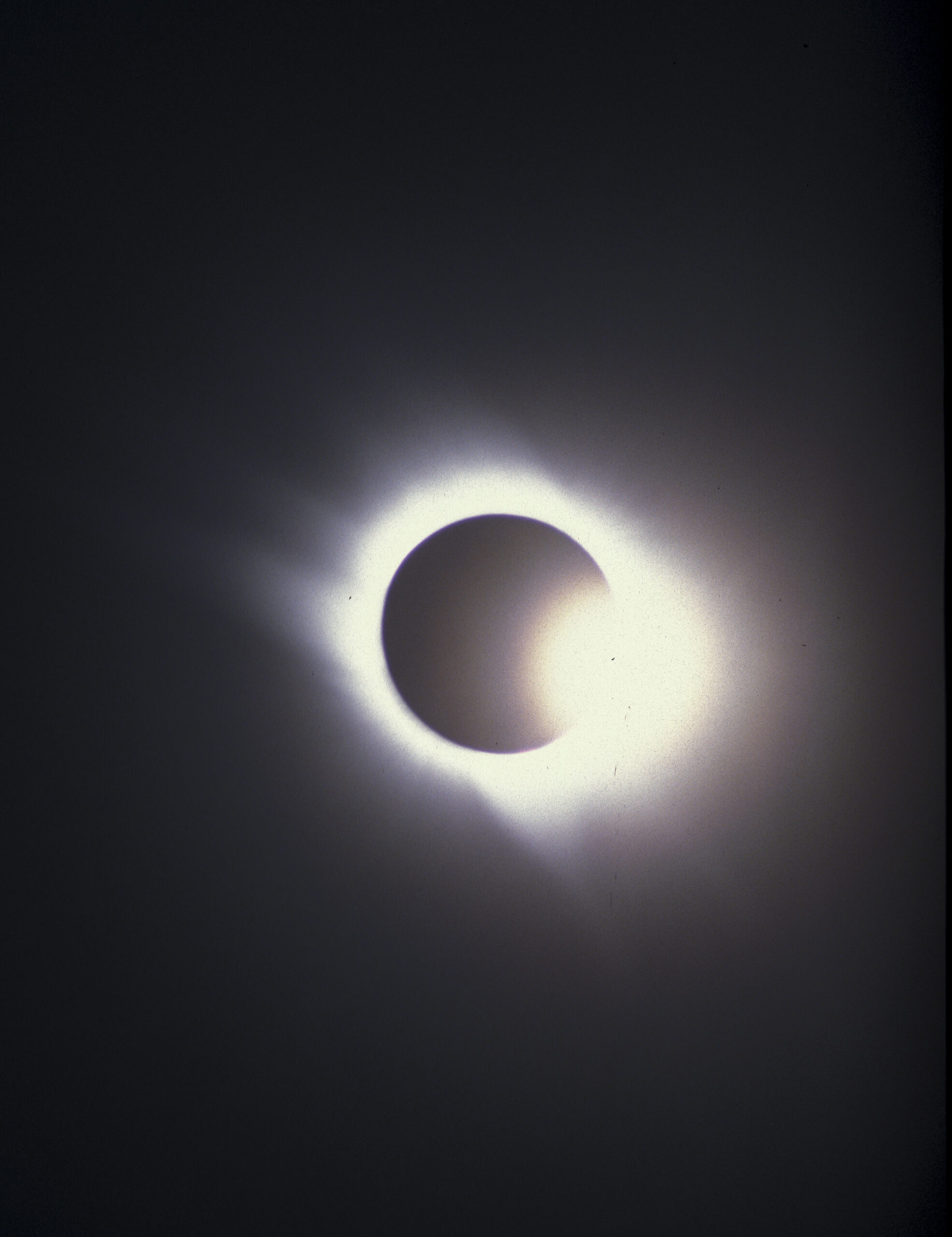
And now a sliver of light peeks out from behind the Moon as that celestial body moves heedlessly on its way. By now, of course, the solar filter is back on the front of the scope.
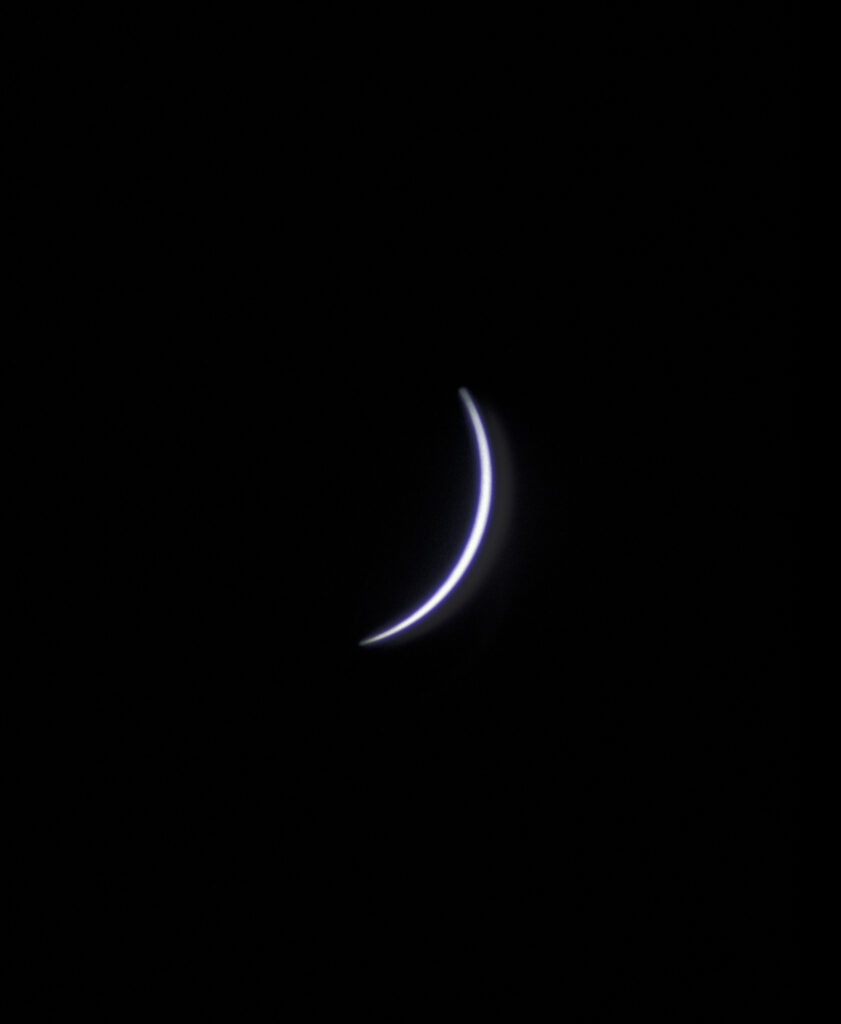
Shortly thereafter, it was day again, and we took its return as an opportunity to have a passerby do a shot of us on Sandie’s camera.
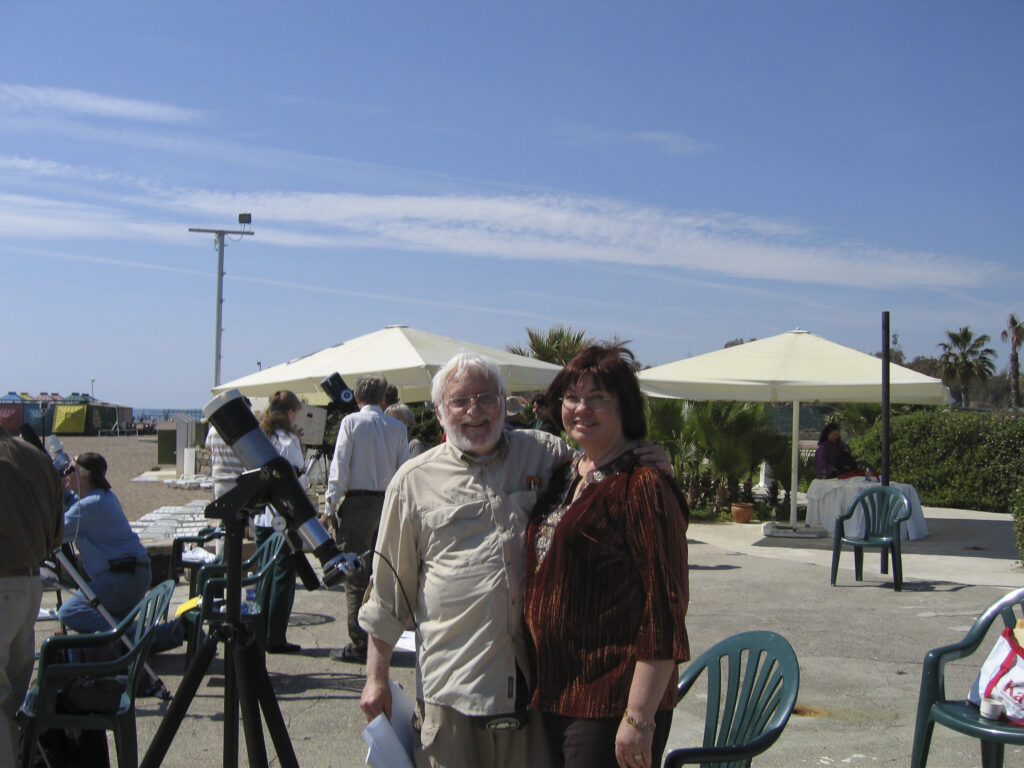
The gap betwixt the edges of the two heavenly bodies continued to widen as we began to relax after the tension and excitement of waiting for, and experiencing, totality.
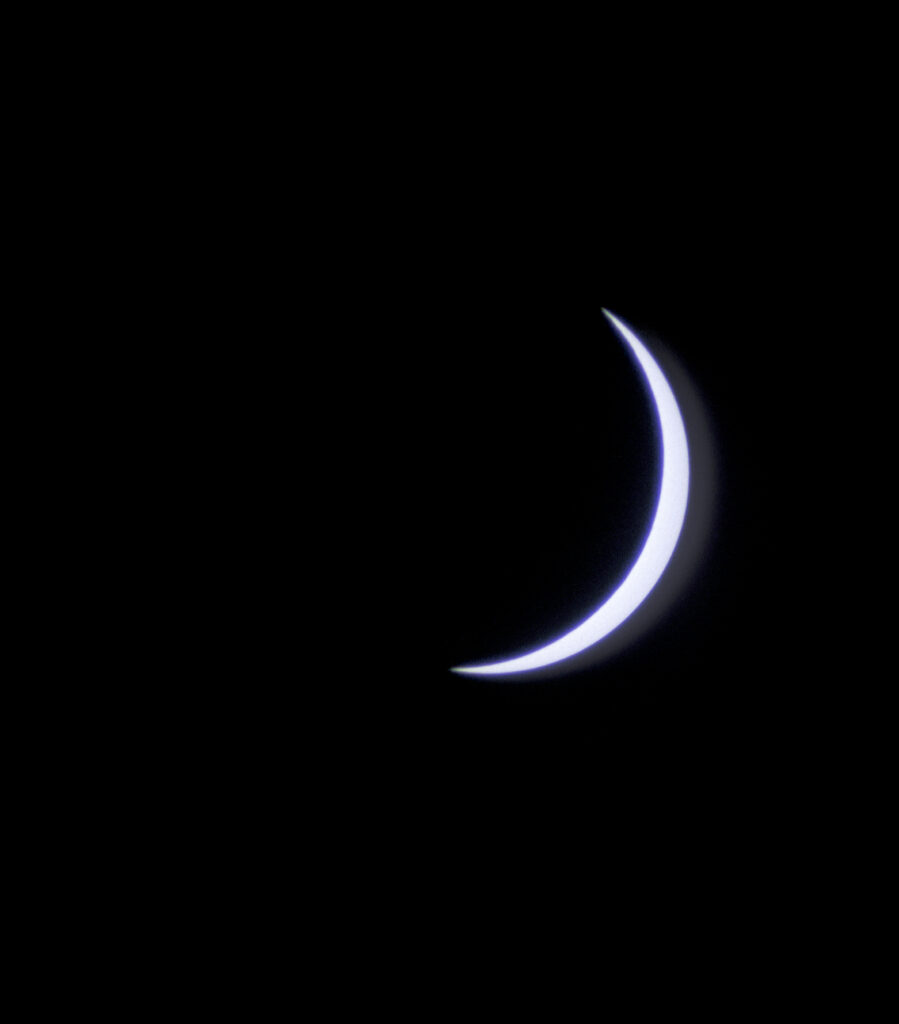
People tend to regard the eclipse as over and done with as soon as third contact passes. The field rapidly became deserted as the eclipse-watchers went off to cavort on the beach or get drunk, with only diehards like Jim Windlinger and myself remaining to record the post-totality phase.
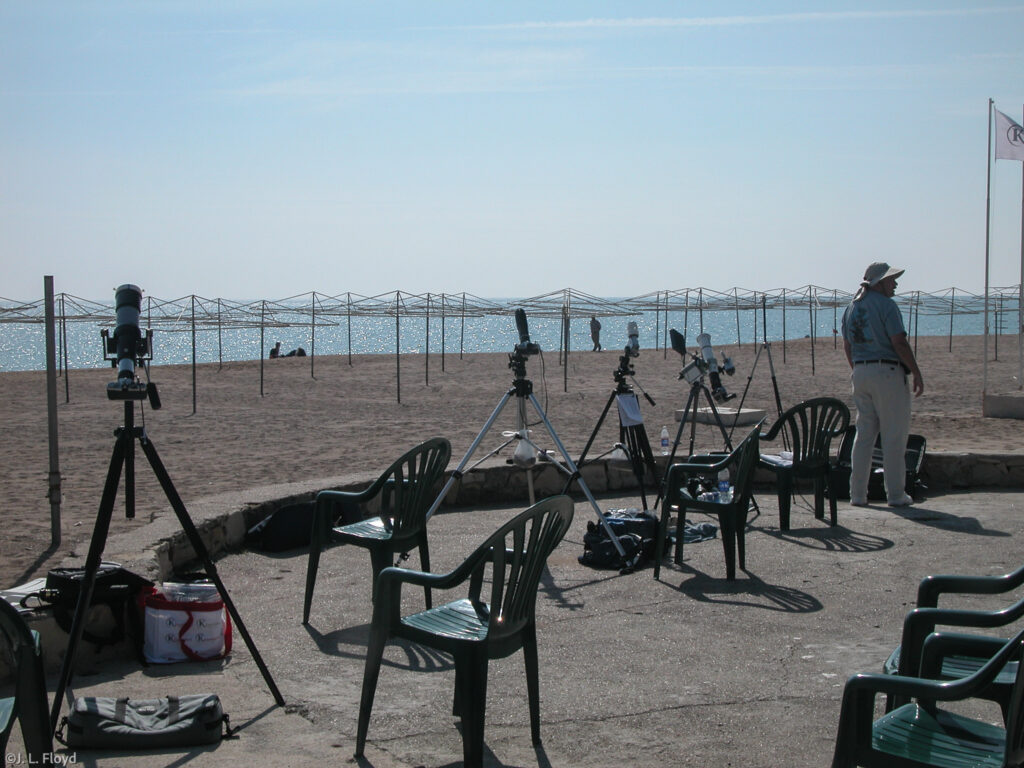
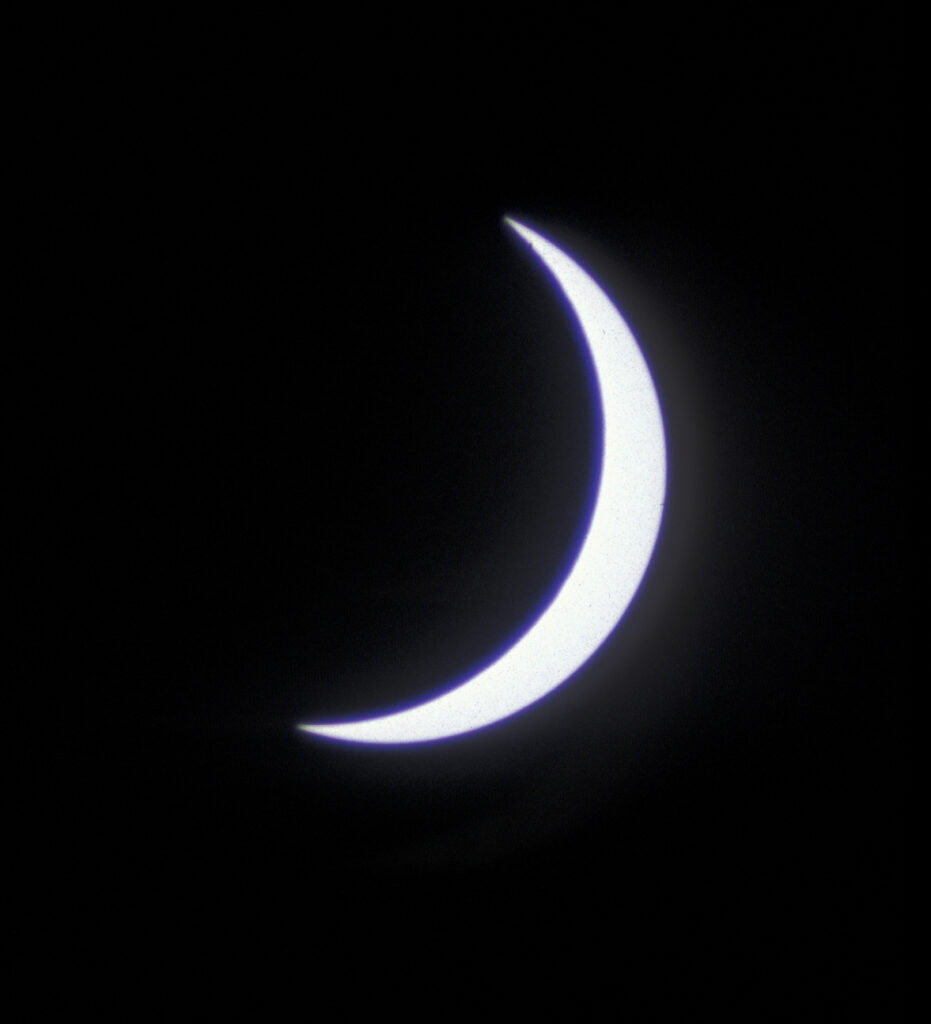
I continued shooting the waxing Sun as long as I could, but I hadn’t brought enough film to last until fourth contact, the moment when the Moon departs entirely from the face of the Sun.
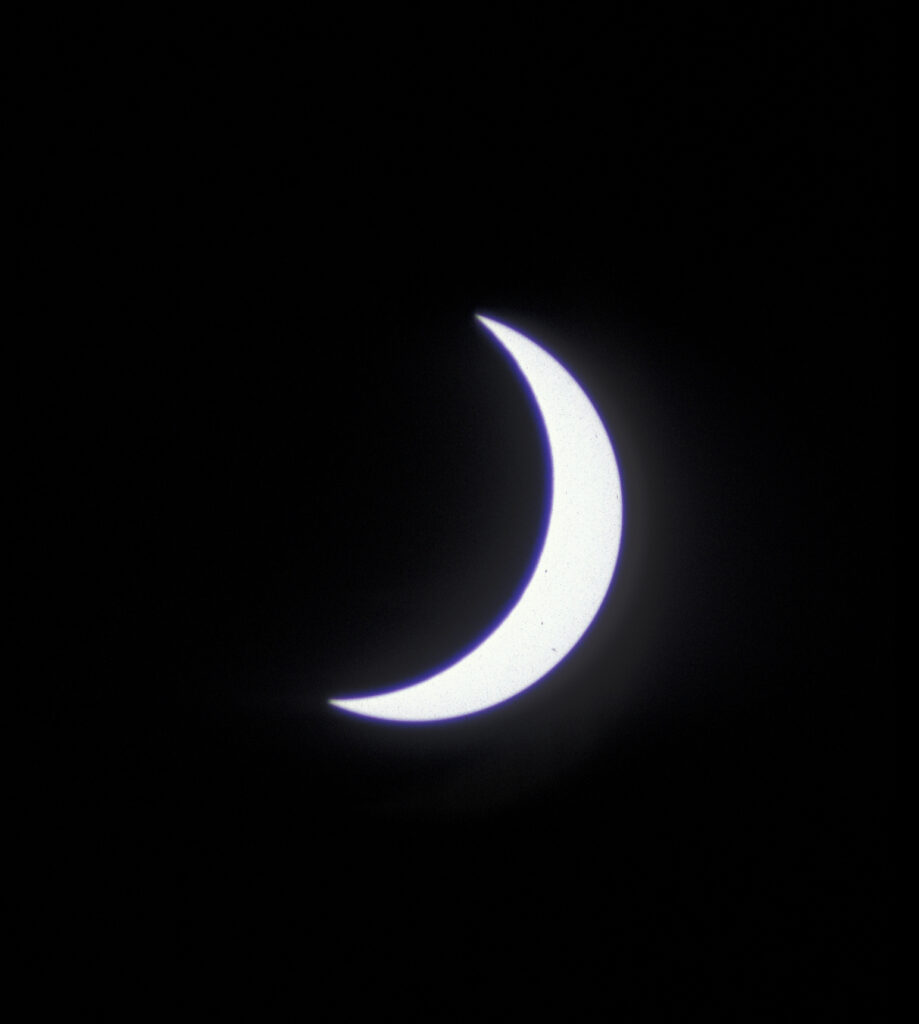
The weather gods had been kind to us that day. They had considerately waited until after fourth contact to send the clouds in, so the eclipse was not interrupted by any unwelcome meteorological events. As sunset approached, however, the clouds closed in, and the next day they covered the country all the way to Istanbul, as we would find out.
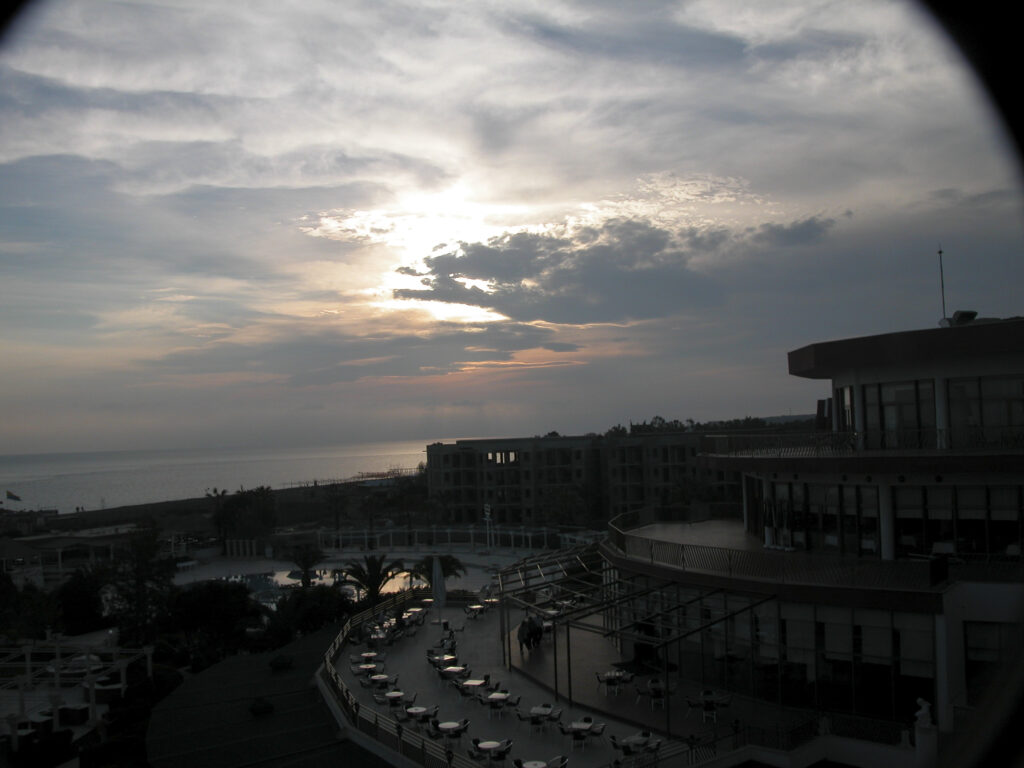
But even though the eclipse was over, the Eclipse Day festivities were not. The Kaya Side staff had prepared for us a truly cosmic blowout, on such a scale that I have to give it a whole page of its own!
